Diving Into the Customer Feedback Survey to Target All Your Customers
Diving Into the Customer Feedback Survey to Target All Your Customers
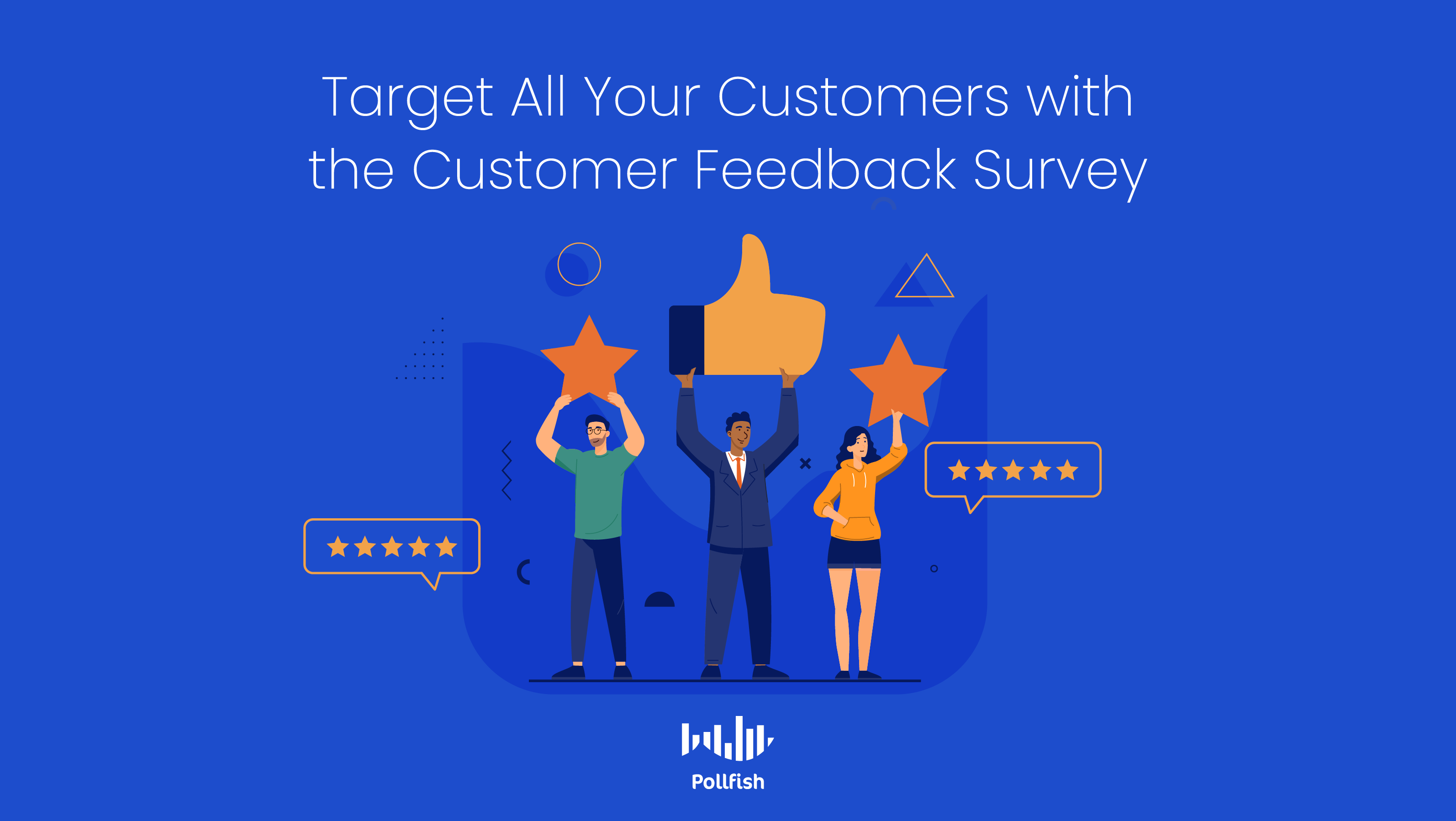
Using the customer feedback survey is the quickest and most effective way to gain ceaselessly coveted customer feedback. This tool provides access to all the opinions and commentary that members of your target market have.
You can use these surveys to run a survey campaign into virtually any topic that you’d like insights on from your customers themselves. While this kind of Voice of the Customer tool may appear to be too general, it is a necessity for brands — and customers agree.
Filling in surveys may also seem to be a chore, but customers appreciate it when brands take their feedback into consideration, regardless. In fact, 77% of customers view brands more favorably if proactively if they invite and accept customer feedback.
It is evident that businesses must acquire as much customer feedback as possible to inform their actions and improvements.
This article provides an in-depth look into the customer feedback survey, its importance, when and how to use it and more.
Understanding the Customer Feedback Survey
As its name implies, this is a kind of survey for gathering customer feedback, which is an all-encompassing term describing all the information that customers provide about their experience with a business.
In this regard, customer feedback can include commentary and insights into a business’s products, services, and various kinds of experiences, including customers’ overall perceptions during their customer buying journey, known as customer experience (CX).
Through the customer feedback survey, businesses also gain insights into customer behavior and various customer consumer preferences. It can provide quantitative market research through various close-ended questions, including numerical ratings questions, such as the NPS survey (Net Promoter Score).
You can also probe deeply into the minds of your target market sample by forming your customer feedback survey as a means of conducting qualitative market research. You can do this by using advanced skip logic in your questionnaire.
This feature allows you to probe further into customer feedback by routing respondents to specific follow-up questions based on the answers to a previous question. You can also make your customer feedback survey take a qualitative approach by using open-ended questions so that customers can fully explain themselves.
You can gauge your customers on specific experiences and sentiments whenever you need to gather specific feedback, especially the kind that is tied to your various marketing/business campaigns.
The Importance of the Customer Feedback Survey
The importance of the customer feedback survey cannot be overstated. This single vessel of customer feedback provides brands insights into any and every concern their customers have. The key is to use it at appropriate times and to use the proper accompanying online survey platform.
Firstly, this survey provides insights into general customer feedback on a brand, which includes customers’ thoughts, ideas, musings and even insights into their customer buying behavior.
In the age of digital experience and CX in general, it is crucial for businesses to be well-acquainted with their customers’ likes, aversions, needs and more. It is equally important to get their feedback on other matters, as this kind of feedback may point out issues you didn't know your customers had with your business.
As such, conducting this survey will reveal many issues you didn't know your brand had, whether it is in the pre-sales stage, the buying stage or the post-sale stage where your customers may return to your brand or switch to a competitor. This kind of feedback allows you to prioritize your efforts on the most pressing matters to your customers.
By understanding your customers’ pet peeves, wants, needs and gathering other feedback, you will, in turn, avoid and lower your customer attrition. Losing customers is never a positive outcome for a business, even less so considering it is 5 times more expensive to acquire new customers than it is to retain existing ones.
The customers that you retain also have a higher probability of buying from your business, as they carry a 60-70% success rate of selling to them. As such, it is critical to avoid customer attrition and maintain a steady flow of existing customers. With the customer feedback survey, you can maintain and increase your customer retention rate, while keeping your customer attrition rate at bay.
Avoiding customer attrition and maintaining customer retention allows you to increase the customer lifetime value (CLV) of your target market. This metric measures the total monetary value a customer has for your business during their relationship with the business.
The longer you retain your customers, the higher their CLV is for your business, representing a constant provider of revenue for your company. As such, the customer feedback survey goes beyond allowing customers to air out their grievances, frustrations and feelings of satisfaction. By supporting customer retention and lowering customer attrition, it helps raise the total value your customers bring to your brand in their lifetime.
However, not all customers provide any feedback. This is problematic, especially when dealing with unsatisfied customers. Only 1 in 26 unhappy customers make their grievances known. Businesses are thus left to fend for themselves when it comes to understanding what makes their customers unhappy, if they can detect this feeling at all among their customers.
The customer feedback survey provides a practical remedy for this, giving businesses an easily accessible tool to extract and gauge customer feedback, whereas, without this tool, most customers would have kept their feedback to themselves.
When and How to Use the Customer Feedback Survey
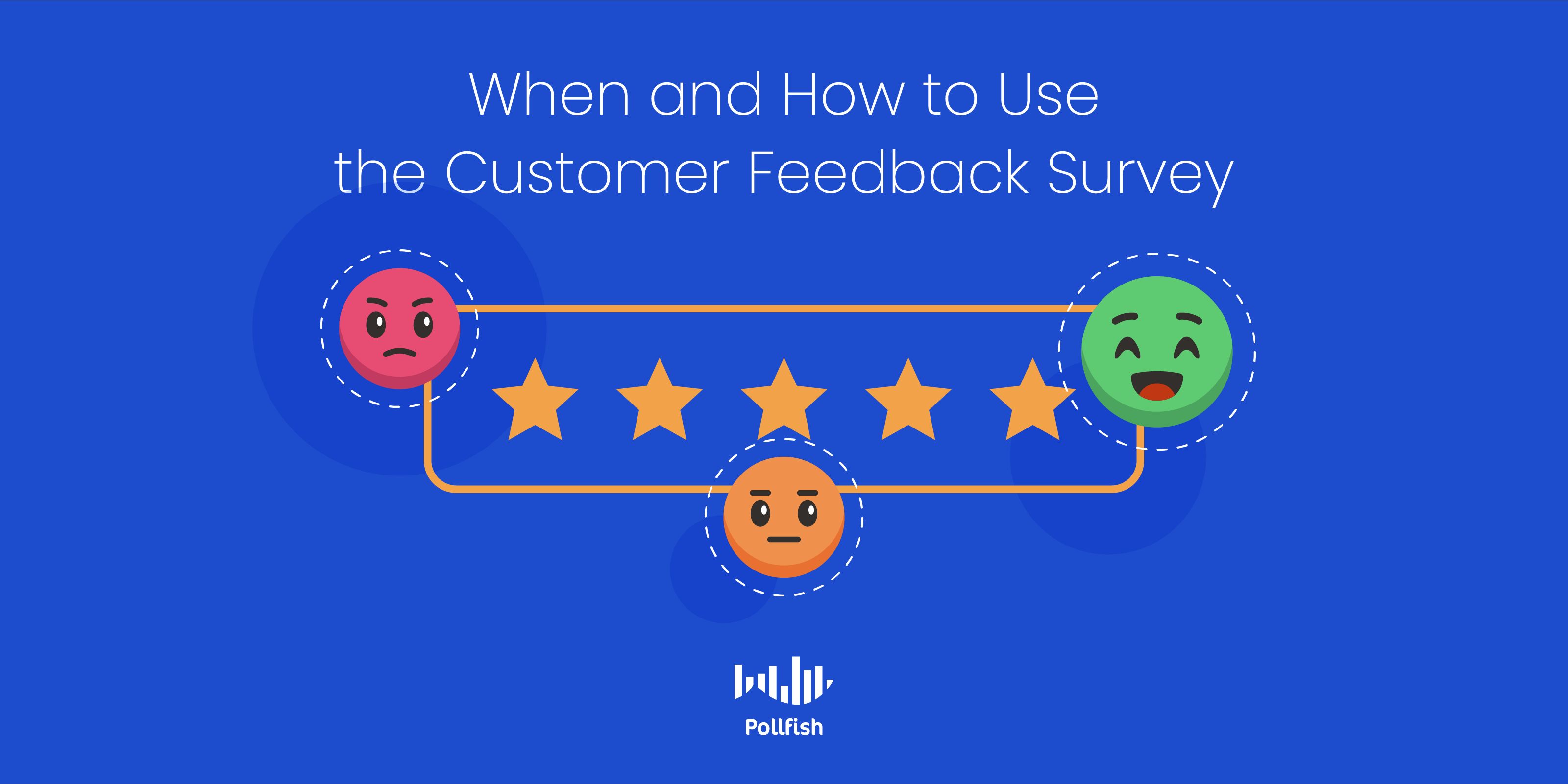 You should create and deploy the survey whenever you seek customer feedback. There are specific times during the customer journey that are especially favorable for collecting feedback, as these are the times in which customers still have interactions and intentions fresh on their minds.
You should create and deploy the survey whenever you seek customer feedback. There are specific times during the customer journey that are especially favorable for collecting feedback, as these are the times in which customers still have interactions and intentions fresh on their minds.
Surveying customers at these moments is conducive to their providing feedback that is honest and accurate to their situation and thoughts. The following lists specific times before, during and after the sales cycle in which you should use the customer feedback survey. It also provides examples of the specific kinds of customer feedback surveys to use:
- Top of the funnel interactions and occurrences customers have:
- When customers sign up for a newsletter, first webinar or subscription list.
- When customers visit a company website for the first time without converting.
- When customers enter a store for the first time and leaving an email address
- When customers inquire about a business for the first time.
- Example: Calling a business for the first time to ask if it offers certain products or services.
- Use a brand awareness survey after customers have first encountered an interaction with your company.
- Middle of the funnel interactions and occurrences:
- When customers watch a webinar for the first time after having had previous interactions with a company.
- When customers watch a second, third or further webinar.
- After a potential client or customer inquires about an upcoming event.
- When customers visit a website and bounce or after having made several site visits without purchasing.
- When customers speak with a sales representative early on in the middle of the funnel (especially useful for B2B businesses looking to secure a lead). Use B2B surveys when dealing with partners, vendors and business clients.
- Middle of the Funnel interactions nearing conversions
- After customers chatted with a sales representative via a website chatting system.
- After customers exchanged emails with a company (especially in B2B settings).
- After thoroughly discussing an integration, plan of action, offerings at length and contracts with an MQL (especially in B2B settings).
- After site visitors browse a website and call/chat about specific products, services and promotions.
- End of the Funnel: Beginning of Purchases
- When customers abandon their shopping carts.
- Use a consumer survey to ask why they abandoned their shopping cart, if they intend to return and what would make them purchase.
- Use the CES (Customer Effort Score) survey to quiz the difficulty customers had with the checkout process or any other part of their CX.
- When customers call in or chat before making their purchase.
- Use the customer experience survey to ask whether your staff answers all of the customers’ questions, if they were helpful and if they pushed them to finally purchase.
- When customers pay for a paid service such as a subscription.
- When customers abandon their shopping carts.
- Post-Sales
- After customers check out their purchase.
- After customers canceled their orders.
- After a certain period of time passes post-purchase as a means of checking up on the customers.
- Use a CSAT (Customer Satisfaction Score) survey to determine the levels of satisfaction customers have with your business throughout their CX and especially with the product.
- Use the product satisfaction survey to gauge how well your product is received and whether customers encounter any glitches/bugs.
- Use an NPS survey to determine how likely customers are to recommend your business to others.
How to Apply the Customer Feedback Survey
You should target specific customers based on their interactions with your business by emailing them your surveys. This can also be done via the following ways:
- Asking customers to take your survey at different social media channels
- Routing them to a customer satisfaction survey in-person (by soliciting their email in-store or at a place of sales.
- Emailing customers your survey based on those in a CRM system or subscription list.

- Deploying surveys to a vast publishing network during, before and after various campaigns, such as advertising, PR, branding and various marketing campaigns.
- Targeting specific customers by emailing them a customer feedback survey.
- These can also be those who don’t know about your business but are part of your target market.
Gaining All the Customer Insights You Need
You should always aim to get as much customer feedback as possible, as it can be applied to numerous campaigns, as well as to simply get a better understanding of the state of your niche, customers and cultural trends.
To extract and elicit feedback from customers, you’ll need to use the customer feedback survey. In order to form and deploy such a survey, you’ll need to use an apt online survey platform, ideally, one that is easy to use, allowing you to make a survey in just three easy steps.
Additionally, a strong online survey platform operates via random device engagement (RDE) sampling, enabling you to reach respondents in their natural digital habitats, as opposed to pre-recruiting them.
You should also use a mobile-first platform, as mobile dominates the digital space, so you would need a survey tool built with the best mobile experience.
The platform you use should also offer artificial intelligence and machine learning to remove low-quality data, offer a broad range of survey question types and disqualify dodgy respondents.
Most importantly, it should allow you to survey anyone. As such, you’ll need a platform with a reach to millions of consumers, along with one that offers the Distribution Link feature.
This feature will allow you to send your survey to specific customers, alongside deploying them across a network.
When you use an online survey tool with all of these capabilities, you’ll be making the most out of your customer feedback survey.
Diving Into the Employee Retention Survey to Avoid Turnover
Diving Into the Employee Retention Survey to Avoid Turnover
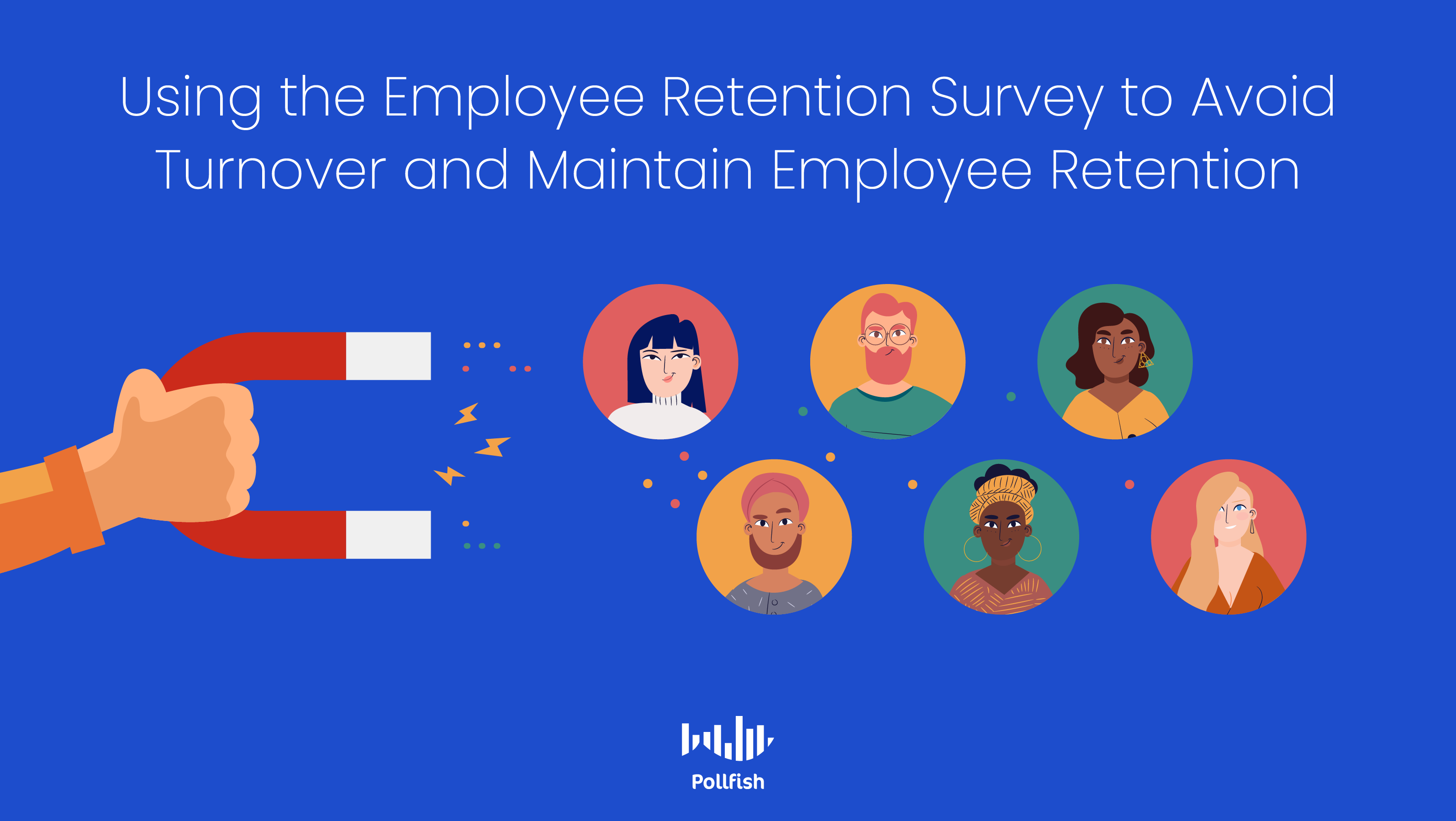
All businesses must conduct the employee retention survey periodically, should they seek to secure employee morale and minimize turnover.
Employee retention is an absolute necessity, as it is the employees that enable a company to operate smoothly, if not entirely. Businesses that fail to prioritize employee retention pay the steep price of high turnover and the ensuing poor reputation. This directly affects brand equity and the overall state of a business.
Despite the importance of employee retention, there are several concerning statistics when it comes to this business aspect. First off, although the average and ideal employee retention rate is 90%, almost 4 million American employees have quit their jobs in April 2021 alone.
More troubling is the fact that 31% of employees have quit their job within the first 6 months of starting with a company. Given these grim statistics, it is no wonder that almost 50% of HR leaders say employee turnover and retention is their top challenge.
Clearly, employee retention is a key challenge that many companies have not been able to properly work out and fully resolve.
This article explains the employee retention survey, its importance, when to use it, how to create it and more.
Understanding the Employee Retention Survey
As its name implies, this is a kind of employee feedback survey, designed specifically to help businesses retain their employees. This kind of survey is constructed so that business owners and HR workers can understand the ideal environments and needs of their employees, so that, in turn, the employees stay with the company.
This kind of survey examines employees on their needs, motivations, desires and current perception of their working environment, understanding of business expectations, along with those of their own position, their sense of belonging, comfort levels, rapport with other employees and more.
Employee retention refers to the number of employees a company manages to keep within a specific period of time. The higher your employee retention is, the longer your employees stay with your company.
Given that the employee retention survey is premised on keeping employees, this kind of survey can include elements from the following survey types:
- The employee satisfaction survey
- The employee burnout survey
- The employee recognition survey
- The eNPS survey, or Employee Net Promoter Score survey
Essentially, this survey can delve into any employee and work-related topic that can assess employee happiness. As such, you can use these kinds of survey types for brainstorming the questions and format of your employee retention survey.
You should also consider regularly running all of these surveys alongside one another, or at least elements of them in one survey, to stay attuned to how your employees are faring in their positions.
The Importance of the Employee Retention Survey
This survey is important on many fronts. It is chiefly important due to the idea of retention. Although employees come and leave organizations frequently, this is not something that businesses should accept.
Instead, businesses should attempt to retain their employees, as high turnover rates harm them. Having to replace employees can be a long and costly process. There is also no guarantee that replacements will perform as well as the employees who left.
However, as previously mentioned, retention statistics are bleak. As a matter of fact, the average employee turnover rate in 2021 in the US is almost 60%. This means that most companies retain less than half of their employees.
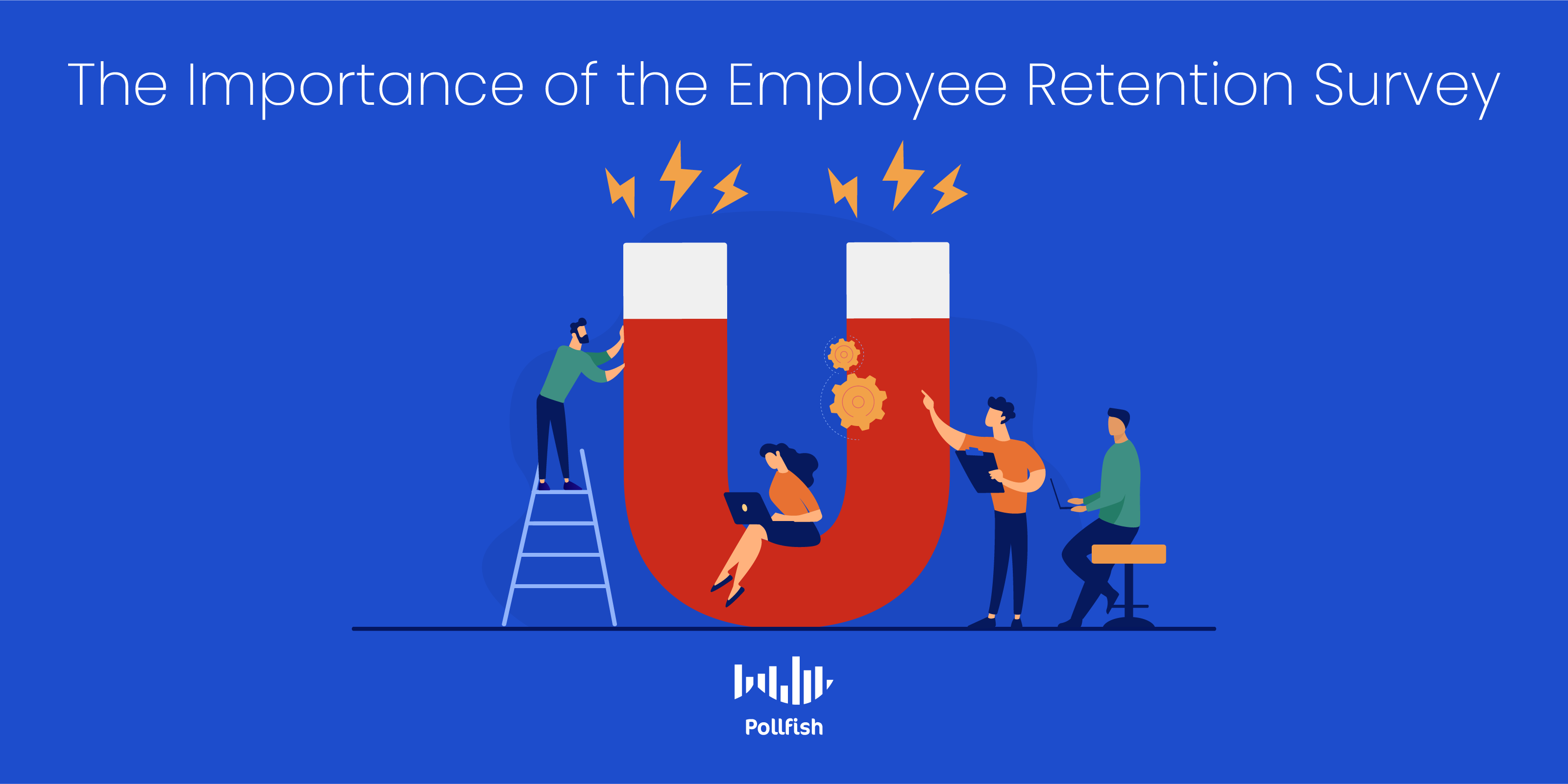
Low retention and high turnover rates reflect poorly on your company, damaging your reputation in their wake. Besides these issues, it will make future and current job seekers hesitant about joining your company.
High employee retention, on the other hand, is rightfully desired, a high employee retention rate maximizes profits. This is because employees who have been with a company longer are far more acclimated with the business than new employees, owing to better performance and knowledge of company processes.
Employees you retain for longer periods do not merely require less training than new employees but tend to be more loyal to the company. In turn, they boost morale and can act as employee advocates for your business. They would do so by recommending your company to others by leaving positive online reviews, through word of mouth and leaving high eNPS scores.
While high employee retention rates can raise profits by four times, high employee turnover is responsible for major US companies spending upwards of $1 trillion on finding and recruiting replacement workers annually.
High employee retention rates can be achieved with the employee retention survey, as businesses who craft it carefully with the proper online survey platform can gain valuable insights on their employees. They can then use these insights to transform and improve their work environments.
A whopping 90% of workers say they are more likely to stay at a company that takes and acts on feedback. Therefore, businesses can directly increase their employee retention by using the employee retention survey. The key is to know when to use them, how to craft them and using a trustworthy online survey platform.
When to Use the Employee Retention Survey
Deciding on the best time to send a survey can be difficult, as there are plenty of other critical business concerns and goings-on. Besides, you ideally would need your employees to dedicate their time to their work, as opposed to taking a seemingly non-essential task.
As such, you should know that there are several opportune times to create, send and analyze your employee retention survey. The list below features these times, along with periods of certain business intents, such as improving something in the employee experience.
- Annually, biannually and quarterly to get a broad view of employee sentiment.
- If you use surveys during all of these time frames, consider setting up different themes for each survey.
- For example, some surveys should be on their own performance, while others can focus on their feelings and perceptions about your business.
- During major times of change, such as a merger and/or acquisition.
- You should wait about a month before implementing this survey, as your employees need to get used to the change, along with its effects on their own positions and new colleagues.
- After a company event, such as a sales event, or a cultural event with your team.
- After they take a training course on your company’s tools and protocols, along with one to enrich their knowledge, such as a course employees are assigned to get a certification after their completion.
- After they’ve completed a major assignment, for example, one that completes their quarterly or other, non-time-based objectives.
- During transitions to different teams or managers.
- After objectives and goals have been communicated to and assigned to your employees.
- These often occur at the end or start of a new quarter or bi-annually.
- During times in which you feel your team needs to improve its productivity.
- This often involves times where employees aren't hitting their goals, or are doing so with difficulty.
- If you’ve noticed, or have been told by HR about moments of tension between employees or employees and their workload.
- When you seek to improve company culture or are curious as to how your employees feel in regards to your business and their job as a whole.
How to Create the Employee Retention Survey
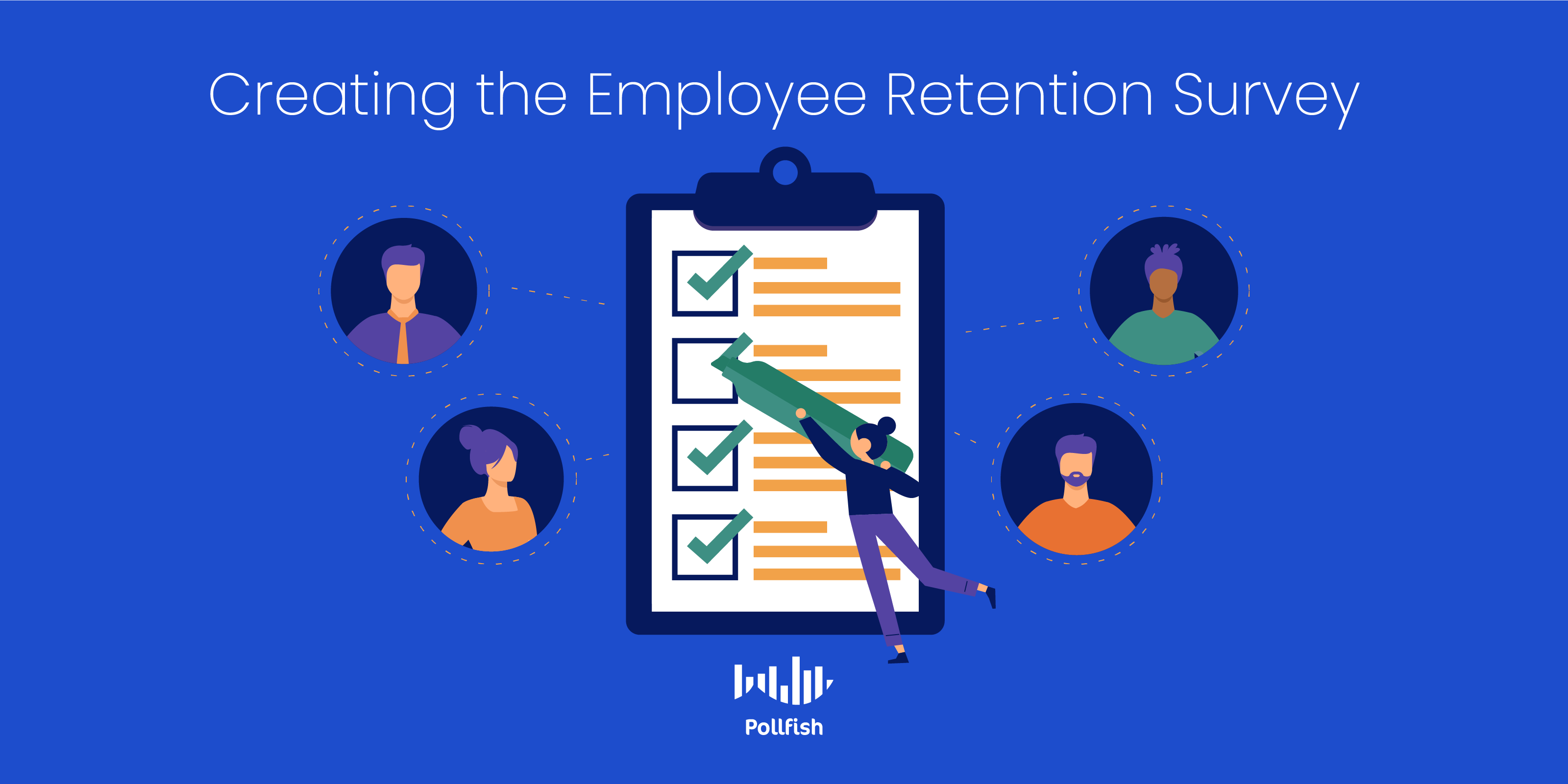
To create the employee retention survey, first decide on the larger purpose of the survey. Use the above section as a guide in terms of the theme and timeframe of the survey. Then, form a preliminary set of questions.
Use a variety of questions to keep your employees engaged and reap quality insights, the kind that won’t require you to elicit more insights/ survey studies. Start by learning about the 6 main types of survey questions. Apply the most relevant types of question types for your set of preliminary questions.
For example, some questions should use a scale, such as Likert scale questions or the aforementioned eNPS survey and its major question. Other questions will warrant using close-ended questions with multiple answers and so on.
You’ll also need to use open-ended questions if you seek to create a qualitative survey. In addition, many times, businesses use open-ended questions as follow-up questions.
For example, if your preliminary question was “which of the following projects did you like working on?,” the follow-up question ought to be “why?,” which requires a thoughtful, in-depth answer that multiple-choice answer questions cannot always provide (although in some cases, you can use multiple-choice questions as follow up questions.
When creating follow-up questions, use advanced skip logic, the online survey mechanism that routes respondents to particular follow-up questions. These questions must be relevant to their answer to a preliminary question.
After completing your questionnaire portion, find the most convenient time for you to send your employee retention survey to your team, along with the most fitting time to announce it and elicit their responses.
If you’d like to learn how to create employee retention survey questions, you can find them in the link provided, along with examples.
Don’t forget to create a “thank you” portion to the survey or a note in your post-survey email to show your team your appreciation and gratitude, along with the importance of their feedback. This provides common courtesy, along with making your employees feel seen and heard.
Use the Distribution Link feature to send the survey to your team. Then, parse the results by filtering data on the dashboard of your online survey platform. Analyze survey data and convene with the HR team to discuss your findings. Finally, take the necessary actions to make improvements for your employees.
Augmenting Your Workspace to Retain Talent
According to various employee retention statistics, including the ones in this article, companies can’t continue to afford to lose their people and to recruit new ones in their place. They should strive for high levels of employee retention and can achieve this through the employee retention survey.
In order to form and deploy such a survey, you’ll need to use a high-performing online survey platform, ideally, one that is easy to use, allowing you to make a survey in just three easy steps.
Additionally, you should also use a mobile-first platform, as mobile dominates the digital space, so you would need a survey tool built with the best mobile experience. This is especially important, as many employees will likely take your survey on their mobile devices.
Most importantly, the online survey platform you use should allow you to survey specific people. As such, you’ll need a platform with a reach to millions of consumers, along with one that offers the Distribution Link feature.
When you use an online survey tool with all of these capabilities and more, you can easily foster employee retention with a strong employee retention survey.
Diving Into the DIY Survey and How It Can Aid Your Organization
Diving Into the DIY Survey and How It Can Aid Your Organization
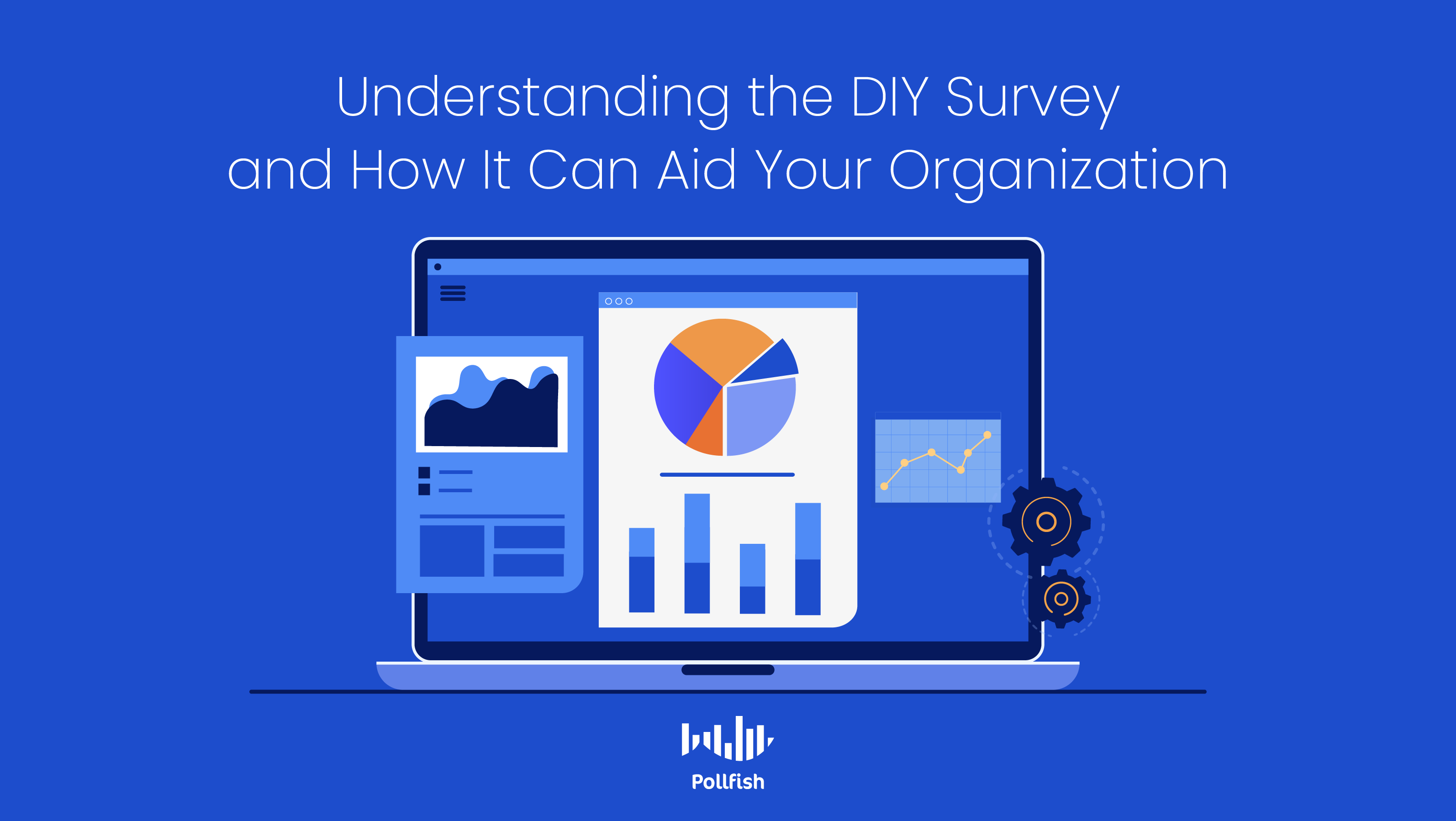 When it comes to primary market research and its chief method of survey research, the DIY survey reigns supreme. To some, this may appear to be subjective, but this kind of survey method sits at the forefront of market research innovation.
When it comes to primary market research and its chief method of survey research, the DIY survey reigns supreme. To some, this may appear to be subjective, but this kind of survey method sits at the forefront of market research innovation.
A DIY survey offers virtually everything that you would expect from the data you extract via syndicated research. The main difference is its benefit of saved time, as this method collects all that is necessary for completion, requiring very little from the researcher.
Depending on the online survey platform hosting this survey, it also applies artificial intelligence and machine learning to disqualify dodgy answers.
Given that market research is a gateway to customer data, a customer data platform is now more important than ever, as 60% of customers have higher expectations than they did before COVID-19. Crafting a DIY survey brings customer insights directly to businesses, so that they can fulfill all of their customers’ needs.
This article explores the DIY surveys, their importance, uses and how to conduct an insights-driven DIY survey study.
Understanding the DIY Survey
The DIY survey is a kind of survey that, as its name suggests, allows researchers to take a do-it-yourself approach to the survey. As such, a DIY survey is a tool that grants researchers ultimate control over their survey.
A DIY survey platform offers multiple capabilities that facilitate the survey creation process. With such a survey approach, the end-user is at the helm of the study; as such, you get to dictate its overall theme, objectives, target market, design, quotas and all else.
However, not all DIY survey platforms offer the same functionalities; as such, some will have more limitations than others, some will have completely different survey sampling methods and these platforms will also offer different levels of reach.
For example, such a platform may offer survey deployment to a wide network of websites and apps, but not offer the RDE (random device engagement sampling method), which captures respondents in their natural digital habitats.
The DIY survey provides agile market research, as researchers can quickly iterate their surveys and test different concepts. Some platforms even provide in-survey A/B testing so that you can test ads and virtually anything else.
The Importance of a DIY Survey
The DIY survey approach allows you to create effective surveys for market research campaigns. Given that surveys are the heart of a market research campaign, it is important to correctly carry them out correctly.
This includes properly creating, deploying and analyzing survey data. The proper DIY survey facilitates all of these aspects.
A DIY survey allows start-ups, early entrants and long-established businesses to evaluate their product, service, experience and brand without spending a large sum of money. They can apply a DIY survey to just about any market research campaign, to support marketing, advertising, branding and other campaign types.
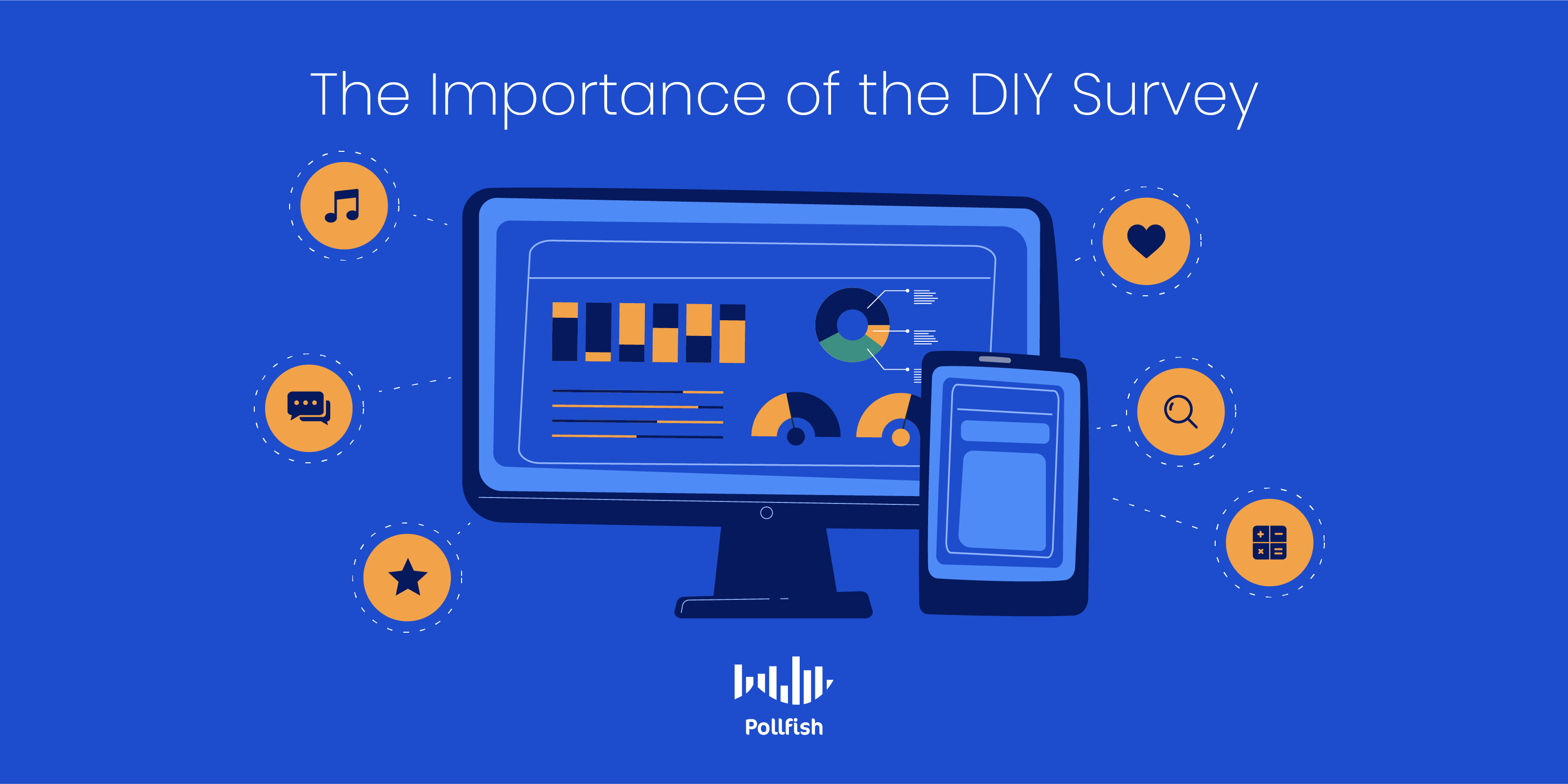 For example, researchers can carry out brand tracking campaigns with the brand tracking survey. Using a brand research platform, they can keep continuous tabs on their business and how it’s perceived.
For example, researchers can carry out brand tracking campaigns with the brand tracking survey. Using a brand research platform, they can keep continuous tabs on their business and how it’s perceived.
A DIY survey is especially important, as it offers three major capabilities: survey design, deployment and sampling and analysis. The following explains the importance of a DIY survey in regards to each capability.
Survey Design:
A DIY survey puts you in control of the survey design. A strong online survey platform allows you to make your own survey in just three steps. As such, it won’t take days or even hours to put together a well-designed survey.
This kind of survey allows you to add all the main types of survey questions. As such, you aren’t bound by one question type or format. Questions can be set up as scales, scores and even icons.
You can also create survey paths based on respondent answers via advanced skip logic, which routes respondents to different follow-up questions, based on how they answered a question. This way, respondents are only presented with relevant questions, the kinds that allow you to probe further on a subject.
When it comes to designing a DIY survey, you are also in control of the target market sample. A DIY survey platform should allow you to target your respondents as granularly as possible, setting qualifications on various categories, such as demographics, behaviors, psychographics, education and many more categories.
It should allow you to target your respondents via screening questions, which enables you to qualify or disqualify a respondent, based on their answers to questions. In these ways, you get to target your audience as precisely as possible.
Survey Deployment and Sampling
A DIY survey makes it easy to distribute your survey to the masses. As such, you don't need to wait for third-party results from a research firm. Instead, you’ll see your results arriving in real-time. A strong survey platform will automatically send your survey to the most highly trafficked websites and apps, exposing your survey to the masses and ensuring that someone from your target population sees it and partakes in it.
When it comes to sampling, an effective DIY survey will apply the aforementioned RDE (random device engagement) method, in which the survey platform gains respondents by extracting the responses of random people from their organic digital environment, as opposed to pre-recruiting them.
This weeds out the possibility of societal pressure to answer in a certain way, along with survey bias. This sampling method grants respondents complete anonymity. As such, they are more inclined to answer truthfully.
Survey Analysis
A powerful DIY survey grants you the ease of analyzing your raw survey data. In the correct platform, there ought to be several displays of your survey results. This includes results configured as questions and answers, charts, graphs, crosstabs and spreadsheets.
It should also include SaaS integrations for you to easily integrate your survey dashboard with other SaaS providers, such as BigQuery. This gives you a comprehensive survey research experience, as you can refer to more than one platform to analyze your results. By integrating them, it makes cross-referencing two sets of data that much more feasible.
A DIY survey platform should offer a robust filtering data capability, so that you do not merely have filtering options in the screening section of the survey, but in the post-survey results as well. You can filter this data in a variety of ways, which includes doing so based on respondent location, demographics, psychographics or answer type.
This grants you easy access to a variety of statistics, allowing you to easily maneuver with all the data you’ll need to power your study.
The Pros and Cons of a DIY Survey
A DIY survey is the foremost tool of modern-day market research, granting you all the insights you’ll need without relying on a third party. If the above section didn't fully convince you of the importance of the DIY survey, the following list of pros will support its prowess.
However, as with anything, this type of survey has a few disadvantages, which you should know about before you implement it for your next market research endeavor. The following lists provide highlights of the pros and cons of the DIY survey:
The Pros
- Ensures complete control over a survey research campaign.
- The main and usually only tool you’ll need to carry out primary market research.
- Provides quick results, protecting researchers from waiting weeks for the survey to be complete.
- Takes as little as a few days or hours to complete.
- Gives you access to affordable research
- Allows you to easily gain consumer, partner (via B2B surveys) and employee feedback.
- Easy to set up and user-friendly.
- Avoids having to rely on third-party results, which may be altered.
- Enables you to set quotas, so you receive the exact amount of answers as you please, from specific groups of people.
- Allows you to add multiple audiences in just one survey.
- Grants you access across all geographies, which makes it possible to conduct global market research.
- Supports data democratization so that all team members have easy access to data and all can contribute ideas on using it for critical business decisions.
The Cons
- Since you’re fully in charge, you’re required to work on all aspects of the survey campaign and keep track of all its details.
- To ensure an inaccurate campaign, you’ll need to measure and keep several variables to a minimum, such as the margin of error and the sampling error.
- You’ll need to be aware of and attempt to reduce various kinds of survey bias.
- You’ll need to be wary of the different kinds of survey respondents; some of them break rules and provide faulty information, such as flatlining or gibberish answers.
- You’ll need to contend with survey attrition; as such, you’ll need to optimize your surveys.
How to Conduct A DIY Survey
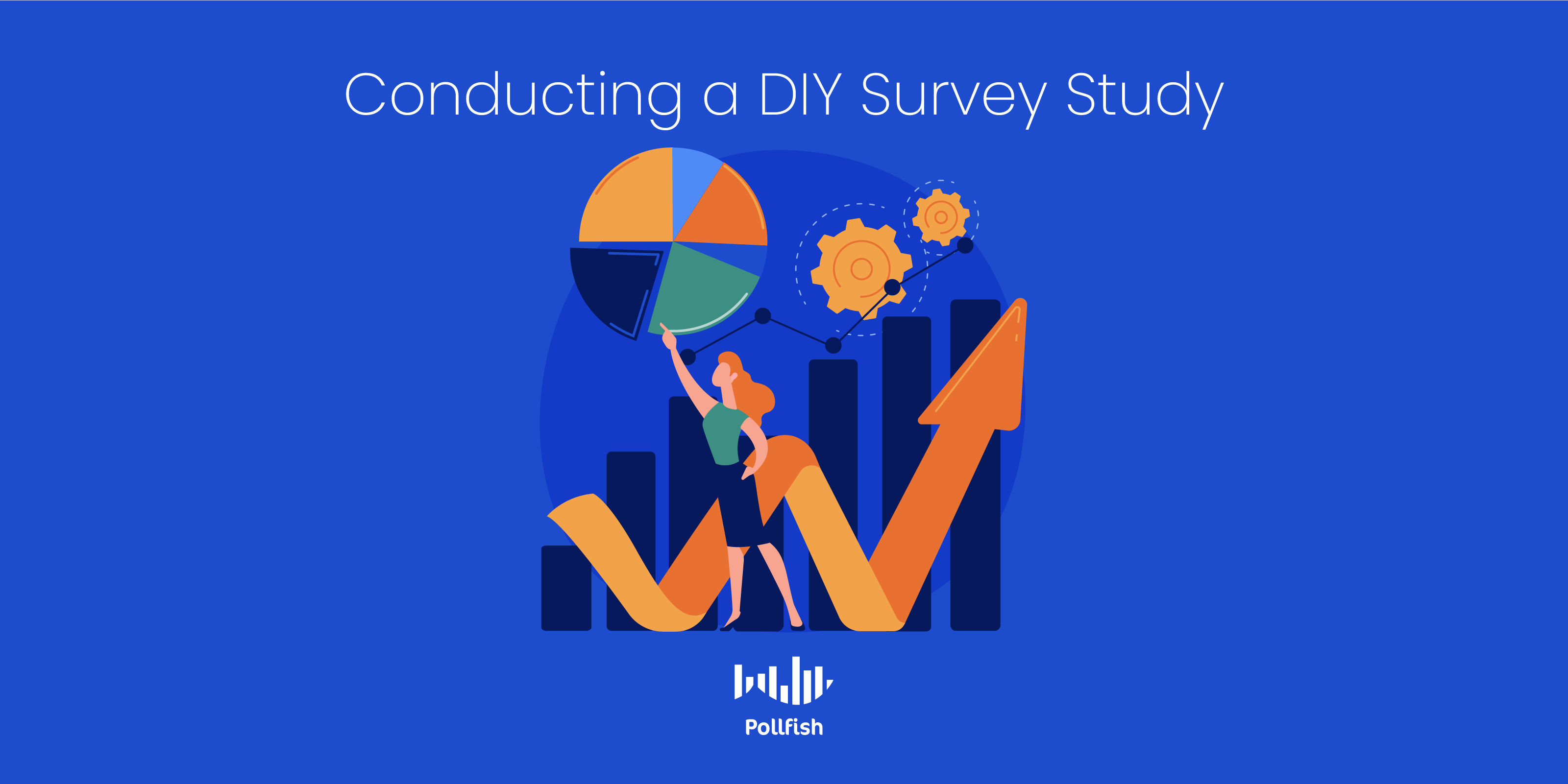
To conduct a successful DIY survey, you’ll need to gather all of your requirements, so you’ll know the best appropriate type of survey to use, along with the best survey method.
The following explains how to conduct a DIY survey:
- Determine what you need to study; consider all the things that matter to your business, such as matters that you have few answers to or would like more clarity on.
- If you have already conducted exploratory or explanatory research, consider other related factors or issues that you’d like to study.
- When you find a topic of study, tie it to a larger purpose or campaign, such as advertising, optimizing the customer buying journey, etc.
- Consider conducting causal research on the matter, as this will find cause and effect relationships.
- If you perform it and identify cause and effect relationships, you may need to rework your intentions or original questions.
- Come up with several preliminary questions. An ideal starting point is to sift through the 6 main types of survey questions and to deliberate which will be most useful and relevant.
- When you’ve come up with 10-15 questions, consider organizing them into two or more surveys. Shorter surveys yield greater survey response rates.
- As you organize your questions, create the appropriate theme for each survey.
- Create a callout that briefly explains what the survey is for.
- Use a strong market research survey tool to create, launch and run your survey to the correct target market.
- Perform a survey data analysis, jot down key findings and share them with your team.
- Take action from your survey findings. You can also create more surveys to test your actions, such as via A/B testing.
Mastering All Business Endeavors
A DIY survey allows you to gain actionable insights quickly, moving the needle for all kinds of business campaigns. But in order to reap the most benefits out of your survey, you’ll need to opt for the strongest online survey platform.
After all, this platform dictates your DIY survey’s capabilities. When you’re deciding on the best market research tool for your business, use a mobile-first platform, as mobile dominates the digital space and you ideally need one with the best mobile experience.
The platform should also offer artificial intelligence and machine learning to remove low-quality data, offer a broad range of survey and question types, provide an estimated survey completion time, offer various viewing options of post-survey data, disqualify low-quality data (such as the aforementioned gibberish answers and flatlining) and more.
Most importantly, it should allow you to survey anyone. We suggest a platform with a reach to millions of consumers, along with one that offers the Distribution Link feature, so that you can not only deploy your survey to random respondents, but to specific people via email, social media, etc.
When you use a DIY market research tool with all of these capabilities, you’ll be getting the most out of your DIY survey. As such, the cons of this survey will be easy to overcome.
How to Collect Customer Feedback with Surveys
How to Collect Customer Feedback with Surveys
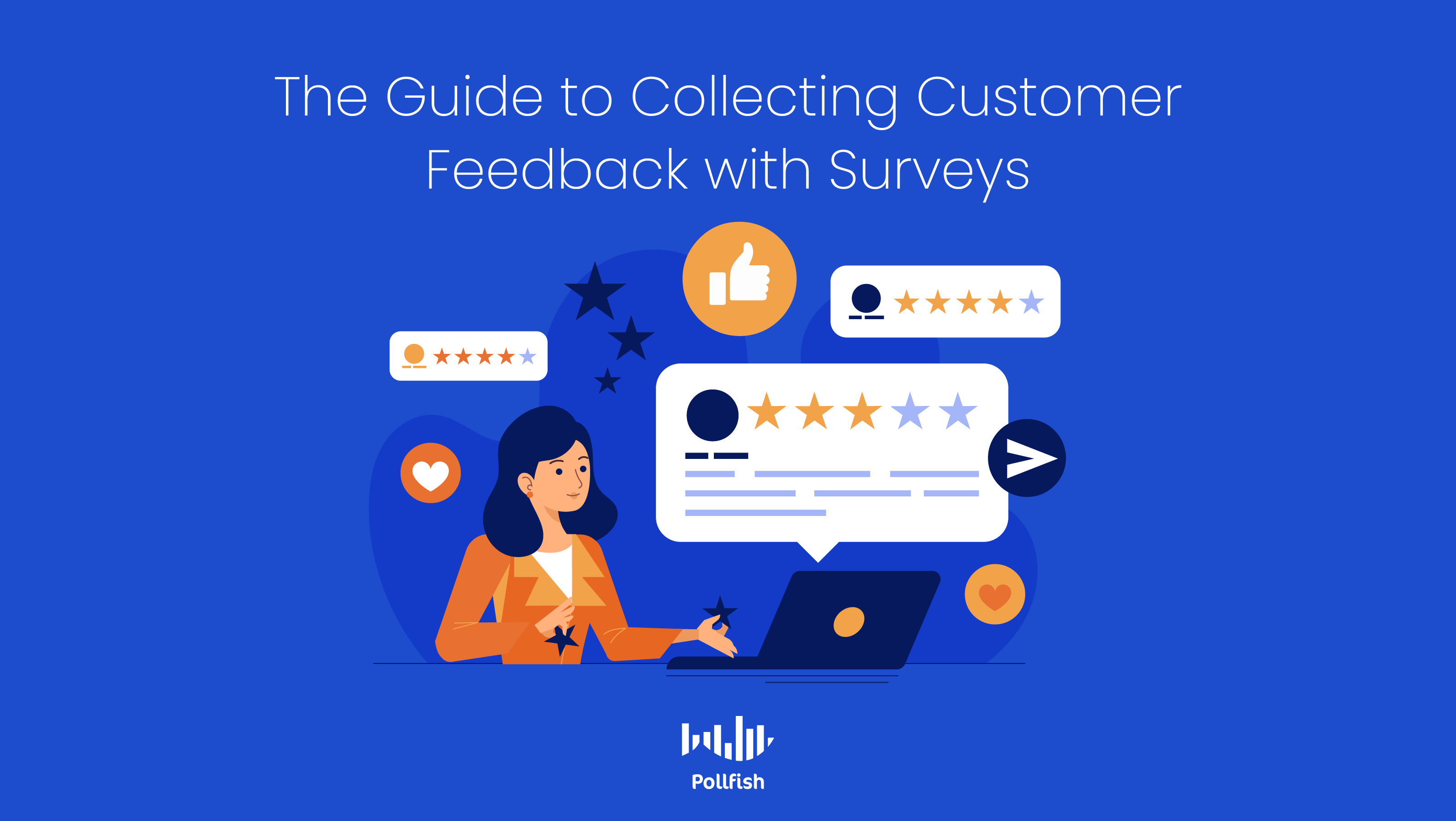
You won’t be able to understand your target market and cater to its needs without collecting customer feedback. Relying solely on secondary market research is a thing of the past, with the accessibility and speed to insights that many online market research tools provide.
It’s now more important than ever to gather customer feedback, as there are so many digital outlets for customers to voice their opinions, be they frustrations or satisfaction.
72% of customers will share a positive experience with a business with 6 or more people. However, 13% of unhappy customers will share their experience with 15 or even more people.
At face value, this disparity may not seem so caustic, when you compare 72% with 13%. However, the challenge lies in the fact that, in most cases, customers don’t share their dissatisfaction with businesses. In fact, only 1 in 26 unhappy customers will complain.
As such, it is up to businesses to extract customer feedback from their customers.
This article provides an in-depth glance into customer feedback and how to collect it with survey research, using the correct methods and the correct tool.
Understanding Customer Feedback
Customer feedback refers to all the information that customers provide about their experience with a business, whether it is in regards to a product, a service, a specific experience and virtually everything else in their customer buying journey.
Customer feedback can be either verbal or written communication from your customers, expressing how they feel when dealing with your business in any capacity. As such, aside from giving feedback on the main issues listed above, customers can sound off on other matters concerning your business, such as advertisements, sensory influences (think taste and smell) and your brand in its entirety.
The purpose of customer feedback is to reveal customers’ degree of satisfaction or dissatisfaction with a business across touchpoints and offerings. This kind of feedback is used to help product, marketing, customer service, customer success and sales teams understand how to improve, ultimately to make their customers happy.
Companies can collect customer feedback through a variety of means, such as interviewing customers over the phone, using VoC programs, asking for reviews, speaking with them in-store and through other means.
You can also passively collect feedback for your team by providing your customers with a place in the product where they can make comments, complaints, or compliments. This is usually facilitated via SaaS and other cloud-based services.
The most potent way of obtaining customer feedback is through polling software, which allows companies to survey the masses belonging to their target market. It can also target specific individuals by sending surveys to them via the Distribution Link feature.
The Importance of Obtaining and Studying Customer Feedback
All businesses, whether they are B2C or B2B, must work towards collecting and studying their customer feedback. This is because, in order to improve your product, service and overall customer experience, you’ll need to understand how your customers feel towards all of these matters.
Customer feedback essentially serves as a guiding source for your business’s growth. It allows customers to express exactly what they appreciate and dislike about your company; this is invaluable information for improving your business and taking any action. After all, you wouldn’t want to launch campaigns that drain your funds while yielding little to no ROI.
In addition, feedback is powerful, as it grants your leadership team insights from the customers themselves, which allows your team to forge a path forward in every part of your business — from product to marketing, through UX and customer support. These insights are especially critical for building and maintaining customer satisfaction.
By gaining customer feedback, your business will be able to sustain a customer-first model that prompts customers to buy from you continuously. As such, using customer feedback is also a key towards building customer retention.
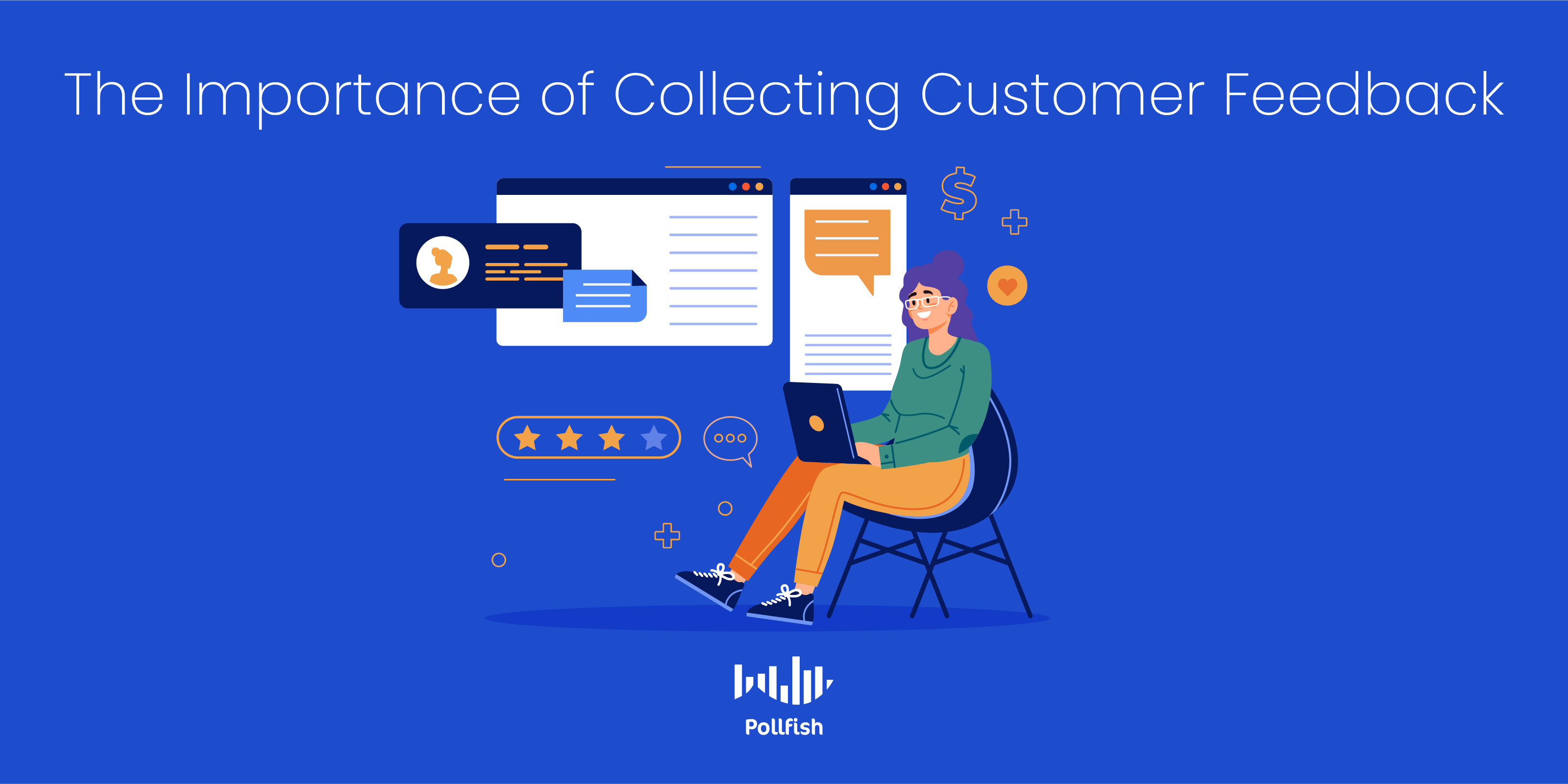
Additionally, customers tend to favor marketing personalization, as no one likes to be sent generic and stagnant messaging and offers. Marketing personalization, as its name suggests, allows businesses to communicate in a hyper-personalized way to customers. But without collecting their feedback, it is nearly impossible to create personalized experiences for them.
Moreover, without customer feedback, your company will never know if customers are reaping value out of your offerings. This presents a major lack for product and go-to-market teams, since without feedback, they’re wasting time and resources on offerings that customers may draw little value from. Remember, as per the intro, only 1 in 26 unhappy customers complain.
When customers draw little to no value from a product, or are unhappy with other business-related interactions and issues, they will leave, increasing a company’s customer attrition rate, while lowering its customer lifetime value.
Needless to say, your business will see an exodus of customers and plummeting sales if it lacks customer feedback.
Despite the importance of gaining customer feedback, customers themselves don’t believe that companies are using this feedback to make any improvements, as 53% of shoppers believe their customer feedback doesn't go to anyone who can actually take action on it.
As such, the three main concerns for your business are to properly obtain feedback from customers, especially the segments on which you seek to run a campaign, to collect feedback at the most appropriate times and to analyze it correctly.
When to Collect Customer Feedback
The pertinent question to ask now is: when should you collect customer feedback? In order to answer this question, you must first mull over WHY you need to collect feedback. There are a few opportune times to collect feedback from your customers. Sending them surveys during this time will be beneficial for your campaigns.
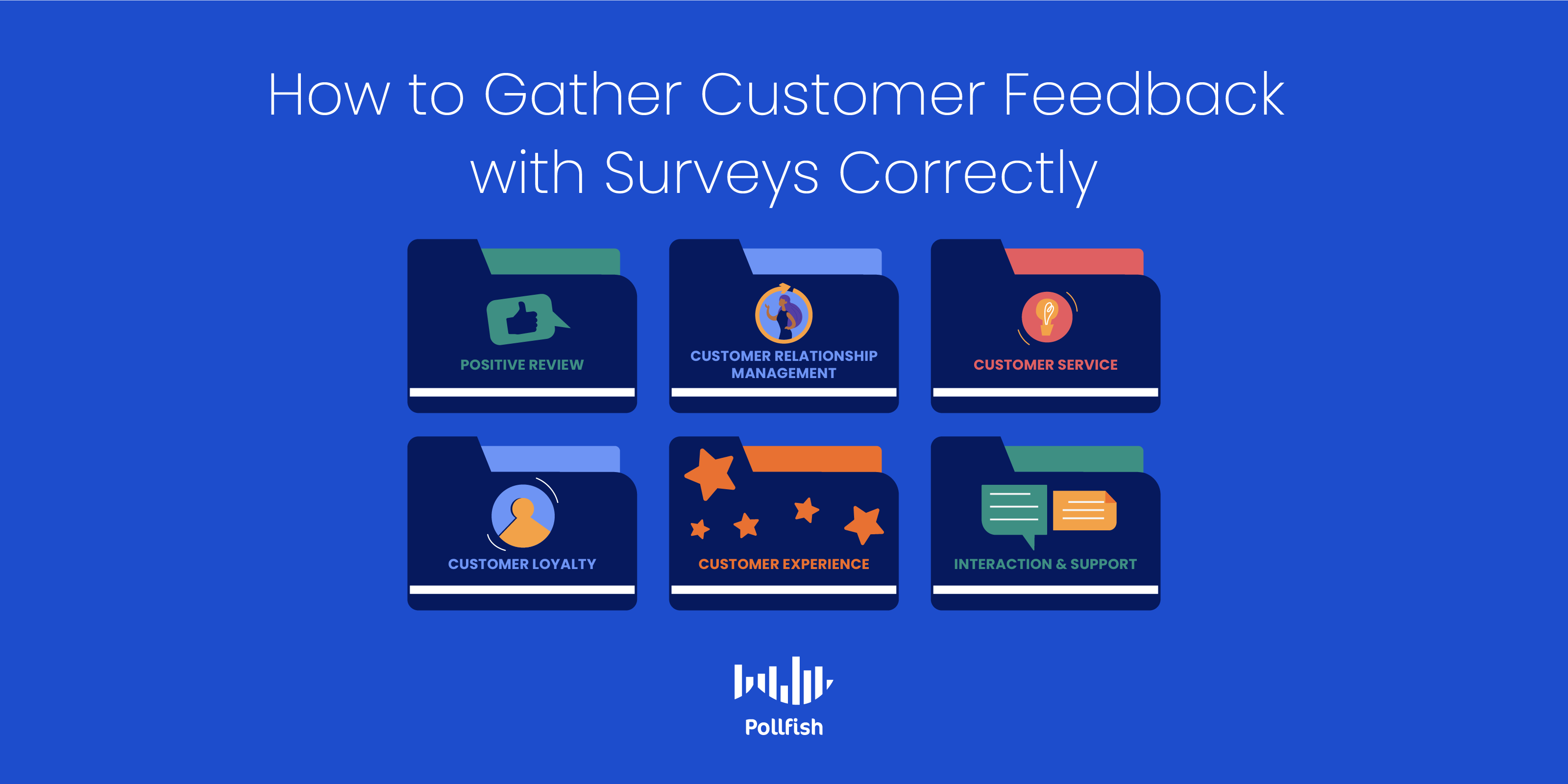 The following lists the most apt times to gather customer feedback:
The following lists the most apt times to gather customer feedback:
- Immediately after customers interact with your content, no matter what stage in the funnel they are in.
- Before you begin working on any marketing, branding or advertising campaign.
- There is a slew of sub-campaigns for each three of these major categories. You ought to survey your target market on their feedback before working, let alone, launching any of them.
- These insights will let you know how to form a campaign, what to include and what to avoid.
- Customer feedback in the pre-campaign stage allows you to avoid snafus and faux pas, including in relation to cultural trends.
- After customers encounter obstacles in their customer journey.
- Whether they have difficulty finding what they need on your website, checking out or signing up for something, you should ask for their feedback to unearth exactly what’s troubling them so you can fix any obstacles quickly.
- After customers checked out (successfully).
- Even if customers were able to check out without issues, you should still get their feedback as a means of checking up on them and your digital experience/ how well your site functions.
- After customers received their order.
- You can obtain product satisfaction feedback after your customers have received their orders and used them. This is usually a few days to a week after customers have received their order, depending on what it is.
- Long-term follow-up.
- This is especially useful if you offer a subscription service or sell a long-term product, such
- When you need to ask them to make a recommendation.
- The most apt time to do this is a considerably long time following a purchase, or several purchases.
- The most common way to test customers whether they would make a recommendation is with the NPS survey.
How to Gather Customer Feedback with Surveys
You’ll need to be strategic when it comes to gaining customer feedback in order to gain valuable data. Surveys provide many formats for obtaining customer feedback.
Once you have determined why you need to collect customer feedback, as the previous section examined and have an end goal, proceed to the next step by asking yourself how you will collect feedback.
An online survey platform offers the most efficient method of gaining customer feedback, as you can survey any demographic group you wish. Surveys grant you insights on all of the situations highlighted in the section that covers when to collect feedback.
To gather customer feedback, first choose the main campaign for the feedback. For example, let’s say your customers signed up for your newsletter.
You can send them a consumer survey to ask how they discovered your brand, why they signed up, what they’re looking for and what they like about your brand. This kind of survey will largely be based on customers’ first impressions and brand awareness.
If you’d like to understand how your customers viewed a recent event you held, whether it is digital, such as a webinar, or physical, such as a grand opening of a store or after they shopped during a promotional sale, conduct an event evaluation survey.
This survey is specifically designed to gauge the CX of your events and can help you see how you excelled, fell short and what to change/prepare fr for your next events.
If you’re dealing with long-time customers, you can send them the aforementioned NPS (Net Promoter Score) survey to determine if your consumers are detractors, promoters or passive customers for your brand. You can ask follow-up questions on how you can improve and take action from there. This way, you can master catering to their consumer preferences.
Connecting with All Your Customers
Customer feedback enables you to connect with customers on things that matter the most to them, allowing you to prioritize all the most necessary actions for improving your business.
The feedback you derive from customers will inform your company on crucial matters as it grows and evolves. This, in turn, helps your business thrive.
You should keep in mind that gathering customer knowledge is a continuous and important practice for any customer success manager or marketer. As such, it is important to choose a robust online survey platform to carry out all of your feedback campaigns.
A strong online survey provider operates via random device engagement (RDE) sampling, which enables you to reach respondents in their natural digital environments, as opposed to pre-recruiting them. This stamps out social pressures to answer in a particular way and cuts back on biases.
You should also use a mobile-first platform, as mobile dominates the digital space, so ideally, you would need a survey tool with the best mobile experience.
The platform should also offer artificial intelligence and machine learning to remove low-quality data, offer a broad range of survey and question types and disqualify low-quality data.
Most importantly, it should allow you to survey anyone. As such, you’ll need a platform with a reach to millions of consumers, along with one that offers the Distribution Link feature.
This feature will allow you to send your survey to specific customers, aside from deploying them across a network. This is especially important for gathering feedback during the specific times mentioned in the section on when to collect feedback.
When you use an online survey platform with all of these capabilities, you’ll be getting all the quality customer feedback you need.
Busting DIY Market Research Myths
Busting DIY Market Research Myths
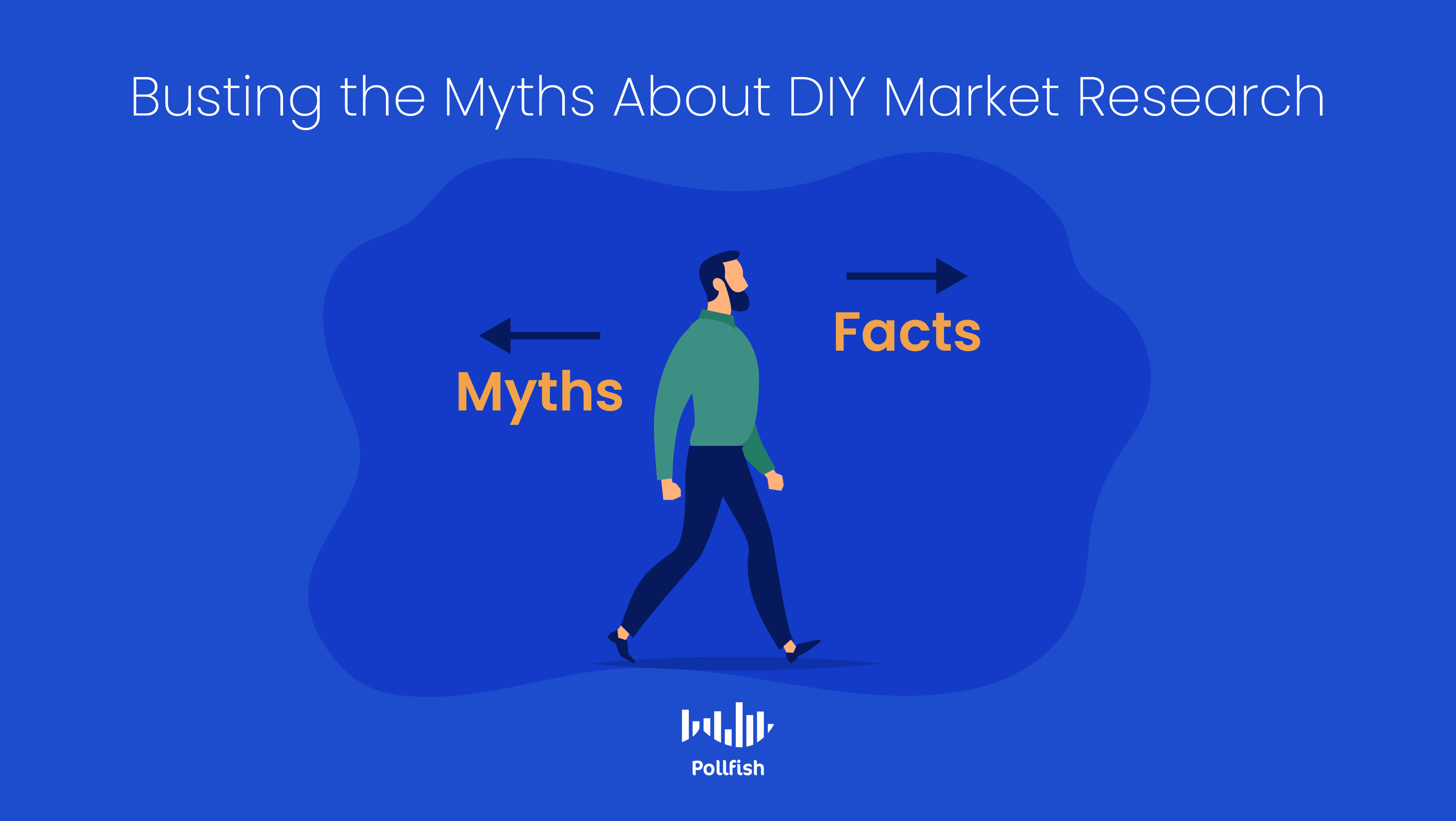
DIY market research has made waves in the market research space, which had at one point been dominated by market research panels and external research firms. Come DIY market research, which brought the entire operation in-house.
This form of research upended the industry, allowing all organizations to conduct and own their market research. In turn, businesses were able to accelerate their processes, gaining quicker results and cutting costs.
Throughout the last few years especially, businesses have had an increasing desire to use DIY research practices. This need has increased throughout COVID-19 with slashed budgets, upskilled teams and the need for faster customer intelligence.
In fact, 54% of companies that have used DIY market research experienced financial growth. Additionally, almost half of market research professionals conduct more DIY research today than they did six years ago.
Despite the convenience and prevalence of the DIY method, negative myths still abound in the space. This article lays out four DIY market research myths and debunks them while proving their value.
Understanding DIY Market Research
DIY research or DIY market research is the practice of conducting market research that any person or organization carries out themselves. As such, the party conducting DIY research can be either a professional or a non-professional.
A kind of primary research, the DIY method uses online research methods, which usually takes the form of online research software or online survey tool. This method provides an avenue to conduct both quantitative and qualitative market research.
A strong DIY research platform provides the following capabilities:
- It can aggregate data from multiple sources.
- It will reach specific demographics, locations and other category-based criteria as indicated by the market researchers.
- It will provide an interface that allows market researchers to enter the stream and test their hypotheses for various types of research.
- It makes it easy to analyze consumer behavior to identify trends and themes.
- It allows researchers to deploy their surveys across a wide network of digital properties.
- It permits researchers to send surveys to specific, targeted individuals.
- It works quickly in extracting the correct data from the qualified population.
- It allows for exports, post-survey data filtering and various displays of the data.
Despite all of its provisions and conveniences, various actors maintain that DIY market research is not for all due to several limitations and factors of inferiority when compared with traditional market research. Despite the pervasiveness of DIY market research myths, they do not prove to be accurate.
Read along to understand why, as we bust four common myths surrounding the DIY approach to research.
DIY Market Research Myths in a Competitive Space
There are long-held myths surrounding the concept of DIY platforms and research. Businesses and market researchers must understand that many of the myths surrounding the DIY approach and its effectiveness are just that, myths.
For online survey platforms such as Pollfish to truly realize their potential in the space, researchers and market research agencies should pay no heed to the myths and misconceptions about DIY market research and instead funnel their energy into finding a strong online market research tool.
Such a tool would facilitate DIY market research with little labor involved from its users, marketers, researchers and business owners. For researchers to overlook the myths about DIY tools, we’ve laid out four to debunk.
DIY Market Research Myth 1: Complexity
DIY tools have many moving parts in the backend, such as segmentation, profiling, filtering and managing projects. With these hurdles, there is therefore also a learning curve to being active users of the tool. As such, the first myth is that DIY market research platforms are more complex than they're worth using.
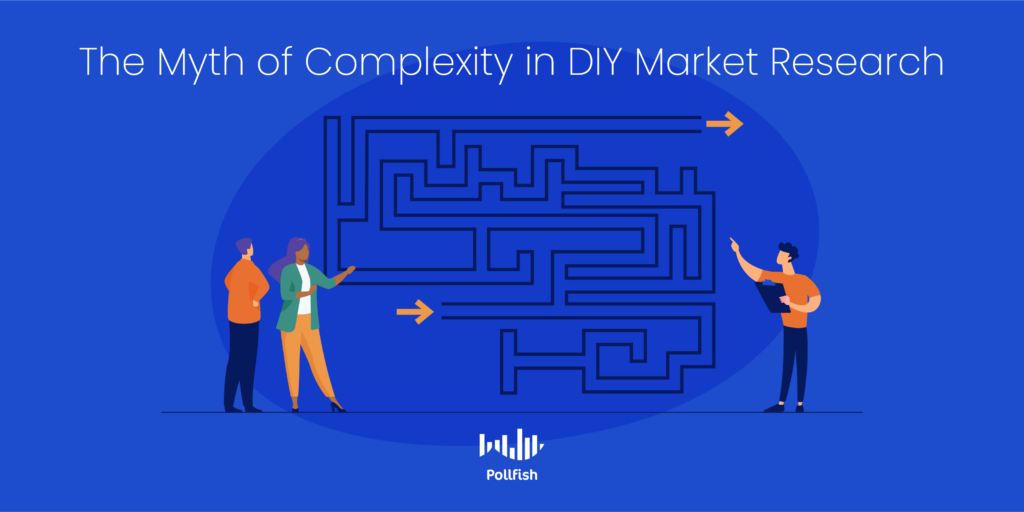
Although there are various components searchers would need to learn how to use, this couldn’t be further from the truth. This is because a strong DIY market research platform is made to be user-friendly, allowing its users to make your own survey in just a few steps. These aspects are the dominant traits of simplicity, diametrically opposing the concept behind this myth.
With various data visualizations such as charts, graphs, Excel files and more, researchers are in control of how they view and analyze their data. These are also easy to access, as they live on the DIY market research platform. This means businesses can cut through the middleman and access their data themselves, as opposed to using syndicated research, in which the market research firm you use owns all the data.
There is also no need to scout out research or survey panels, which are composed of pre-recruited respondents who agree to take part in a market research study. All researchers need to do is determine their audience, add in their questionnaire and launch the survey. That’s it. The DIY platform takes care of the rest.
This is a major reduction of labor, hassle and worry on the part of the market researchers using the DIY tool. As such, it is not merely a simple method, contrary to its myth, but it is one of the simplest if not the simplest way to conduct research.
Myth 2: DIY Platforms Favor Speed Over Quality
While it is true that DIY research platforms offer speed to insights and can empower researchers with an agile research strategy, they do not compromise speed over quality. Instead, these platforms offer both accelerated data collection and quality responses.
This will largely depend on the DIY market research platform you use. However, a robust platform often guarantees netting quality data only from researchers’ intended audience. It delivers this promise of quality data by preventing fraudulent responses. This involves using a series of in-platform mechanisms. These are powered by machine learning and require no effort on the part of both the researchers and the support staff of the DIY tool.
These mechanisms involve using a variety of quality checks that ensure there are no questionable respondents or faulty answers. Some of these quality checks include:
- No tolerance for gibberish answers
- Disqualification of VPN users
- Banning rule-breakers
- Barring respondents who provide one-word answers in open-ended questions that seek in-depth answers
- No tolerance for bots
- Avoidance of respondents with duplicated IDs via IP or MAC addresses, Google Advertising and mobile device identifiers
- Technical layers of quality checks
With the above quality checks and more working to eliminate any subpar data and suspicious respondents, market researchers are not sacrificing the quality of their research for the convenience of speed. Instead, a DIY market research platform couples speed with quality data.
Myth 3: DIY Platforms are Only Suitable for Simple Studies
The myth that DIY platforms lack the sophistication found in traditional research methods, such as using syndicated research or a market research agency has been long-established. After all, DIY market research platforms have given these organizations a run for their money and positioned themselves as legitimate threats.
Full-fledged market research agencies do offer value in the market research ecosystem, as they offer high-grade expertise in research design and storytelling. This gives their consumer base of market researchers a high level of quality behind their services.
However, these services do not render DIY market research platforms inferior. They are simply another route for conducting research, ones that are older and don't offer all of the conveniences that market researchers have at their disposal by using a DIY market research tool.
One such convenience is building a multi-level survey campaign, the kind that offers various question paths via advanced skip logic, a mechanism that routes respondents to the appropriate follow-up questions based on their answer to a previous question.
This creates deep and multi-pronged question paths in the surveys that researchers create, allowing them to reap granular insights and deeply explore a topic, despite the different customer personas present and their varying answers.
They can do all of this in just one survey. Thus, this capability disproves the fact that DIY market research platforms can only be used for simple studies.
Moreover, DIY survey platforms allow market researchers to segment qualified respondents in an ultra-granular way. This means they would not simply tick off demographics, psychographics and location when profiling their qualified users in their screening section.
Instead, they can qualify and disqualify respondents from taking a survey based on their answers to specific questions in the screening section, which makes the segmentation process extremely granular. Researchers will never be left wondering if the right people are taking part in their surveys.
In addition, they can add multiple audiences to their surveys, which grants researchers the ability to include multiple groups of respondents with distinct characteristics to partake and be examined in just one survey. A tool that can do this isn’t lacking when it comes to conducting complex studies.
As such, DIY survey platforms are well-equipped to manage complex campaigns that require deep segmentation, multiple audiences and varied question paths.
Myth 4: Automation Sacrifices Business Impact
This myth is centered on the idea that using a DIY market research tool removes the human-led element of storytelling available in research agencies, thereby making this kind of tool less insightful and far less impactful on the overall research campaign. This is a myth as DIY research platforms are continuously augmenting their capabilities.
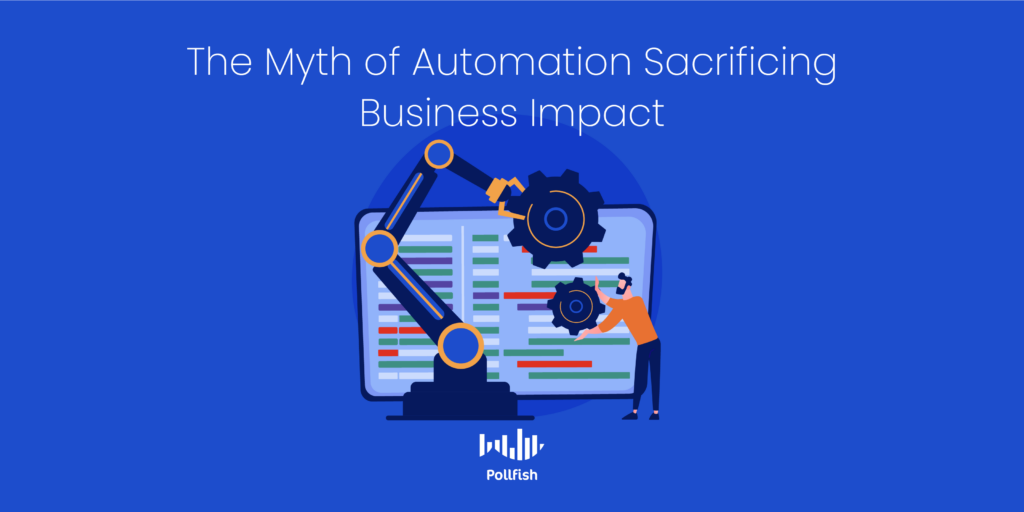
At Pollfish, for example, there are ongoing updates to the product which makes it more innovative, practical and adept at keeping up with changes in the industry.
The constant updates present in DIY market research include real-time analytics solutions and dashboards, which show the progress of a survey while it is still running. They also make it possible to access the data in various formats, visualizations and organizational styles, such as filtering post-survey data in the dashboard to focus on specific demographics and answers.
These automation-based features enable the DIY platforms to ensure data democratization, which entails all members of a business having easy access to insights, whether they are market analysts or in a far different department such as e-commerce, marketing, C-suite, etc.
These capabilities provide sufficient impact for businesses on a wide spectrum of efforts, such as marketing, sales, and advertising as they enable them to make data-driven business decisions, the kinds that are mission-critical.
Making All the Right Market Research Moves
Using DIY market research allows you to efficiently perform all the research you require for multiple projects. While it is clear as to why DIY market research myths are invalid and are just myths, it is important to understand that not all DIY market research platforms are built with the same interfaces and capabilities.
Market researchers should choose an online DIY platform with features that easily disprove these four myths and others. This way, they can safely carry out their market research campaigns, knowing that they’ll reap accurate and high-quality results.
To do so, they ought to look into a strong online survey platform, the kind that operates via random device engagement (RDE) sampling, which reaches respondents in their natural digital environments, which, in turn, cuts out survey bias.
Market researchers should also opt for an online survey platform that implements artificial intelligence and machine learning to disqualify survey fraud and poor-quality data, provide a mobile-first approach design and offer the Distribution Link feature, which allows researchers to send surveys to specific targets, as opposed to a random pool.
When you use an online survey tool of this caliber, you can rest assured that no myths, no faults or other market research issues stand a chance in marring your market research.
Diving Into PR Surveys to Boost All PR Campaigns
Diving Into PR Surveys to Boost All PR Campaigns
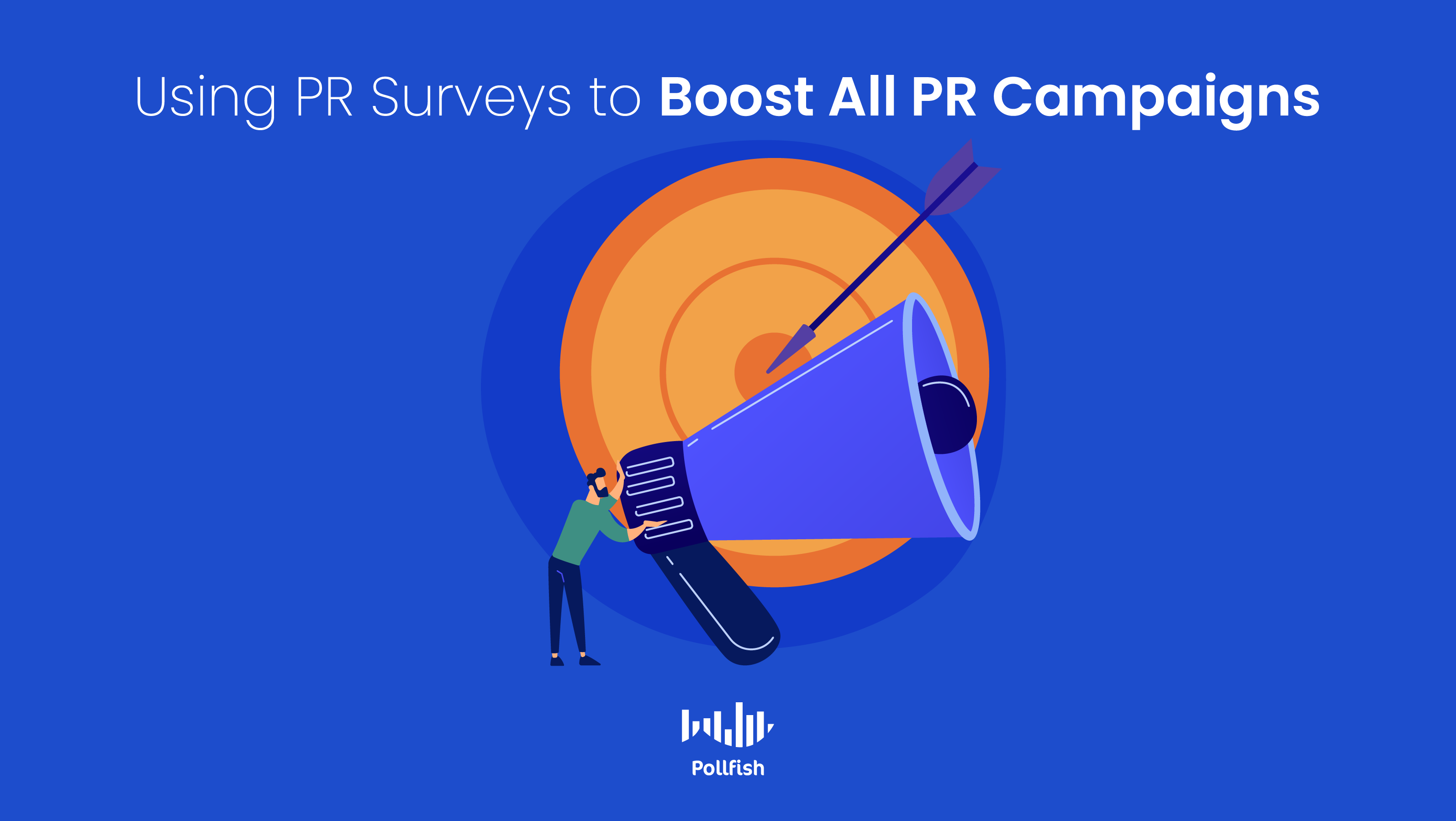
PR surveys provide companies with a lucrative way to bolster all of their PR efforts.
That’s because survey research provides businesses with exclusive findings, the kinds that allow them to differentiate themselves from other competitors in the field. Your business can use all the insights you’ve gathered from PR surveys to drive various PR campaigns.
As the public relations field continues evolving in the digital age, brands must evolve with it and use its innovations to their full advantage. 80% of PR professionals say that the future of PR lies in digital storytelling. Surveys provide the fuel for all storytelling content for a variety of media output, from press releases to journalism sources.
You can use these surveys to enhance brand visibility and positively shape the perception of your brand.
This article focuses on PR surveys, their importance and how to create and promote this kind of survey study to power your PR campaigns.
Understanding PR Surveys
PR surveys serve as the leading technique of PR polling, a method that blends PR with market research techniques, in which surveys are administered to a business’s target audience or a general population, for the purpose of sharing the results via branded content, press releases, company outreach, news, blogs and media outlets.
The questions in these surveys are created strategically, so that they do not merely obtain primary market research, but can be adequately used for broader communications purposes, such as attention-grabbing headlines and news stories.
With PR surveys, businesses can broadcast key messages of their organization while concurrently gathering public opinions of them, along with garnering original insights they can later use in PR campaigns.
As such, these surveys can touch on a wide array of topics, from current events, to things that are relevant to a niche and occurrences within a company. Given that much of PR is centered on gaining media placement and coverage, it is ideal to use a topic that will draw media attention, along with that of your target market.
The Importance of PR Surveys
PR surveys offer a wealth of benefits when it comes to PR polling and various other PR and marketing initiatives. In fact, these surveys can be the main factor behind success in today’s congested media landscape.
PR surveys allow you to craft narratives that get the attention of reporters, bloggers and their audiences. This is because these surveys are vessels to original insights on a swath of your topics of choice.
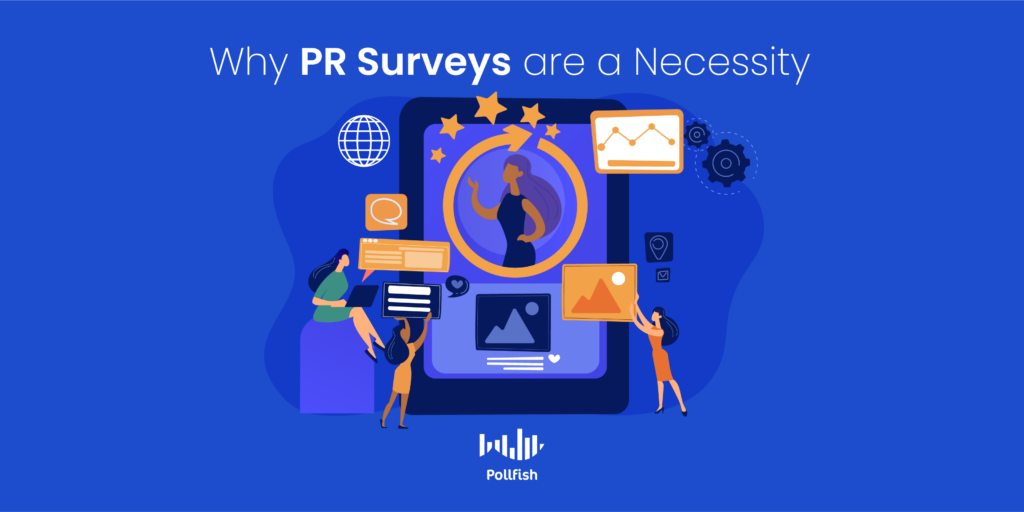
They provide businesses with exclusive insights, exceptionally important, given that 39% of publishers desire content with exclusive research. This means, you’re better off getting media placement by conducting PR surveys than you would be otherwise, including through less efficient means of conducting primary market research.
Further supporting media placement and wide dissemination, PR surveys put companies in charge of their narratives, at least at a high level. This is because you are completely at liberty to ask whichever questions are necessary and to apply any question formats, so long as the online survey platform allows it.
You should be able to freely choose from the 6 main types of survey questions and use them in your survey. You can structure your questions in a way that incites intriguing and unexpected insights. This way, your findings and their subsequent content release catch the attention and interest of news websites, readers and consumers.
As far as content is concerned, 9 out of 10 in-house communications team leaders struggle with content creation. Given that content is a major component of PR, your PR efforts are largely dependent on releasing content that draws in various key players, such as those aforementioned. PR surveys are content machines; aside from aiding your efforts with original insights, they provide narratives you can convert into stories for a wide variety of assets.
These surveys also give you a major edge in general marketing, especially when it concerns thought leadership. Rather than aggregating content or performing secondary market research, the insights you glean from PR surveys are entirely original and proprietary to your company — unless you use the syndicated research approach — in which you source a market research firm to own and conduct the study.
As such, you can power a wealth of campaigns with the original insights you extract with these surveys. This allows you to be considered a thought leader, as you can focus your studies on a particular topic of study that your competitors haven’t, or at least not with original insights.
These campaigns can include lead generation, allowing you to gain more leads by producing downloadable and gated assets such as reports, whitepapers, infographics and more. The press releases you send can link to the landing pages of these lead generation assets.
In this way, PR surveys can also boost SEO and site traffic. Since the main goal of a public relations study is to attain media attention by way of online news stories, you can lead more people to your website organically by link building.
An intriguing study will garner backlinks from other earned media placements, including bloggers in your niche and major new publications. Aside from generating attention, backlinks allow websites to rank higher in search engines.
The Content Benefits of PR Surveys
To piggyback off of the previous section, PR surveys provide a range of PR and marketing benefits, along with being strong market research tools. When it comes to content specifically, which PR is highly reliant on, there is a wide scope of content assets that your PR survey can yield.
These assets maximize the return on investment from your polling campaigns.
The following lists some of the various content assets you can churn out from your survey findings:
- Blog posts
- Press releases
- Industry, consumer or current events reports
- Whitepapers
- Infographics
- Webinars
- E-books
- Resource pages on your website
- Social media content
- Guest posts on other media websites
- Video content
- Downloadable assets
How to Create a PR Survey & Properly Promote It
When you’ve decided to use a PR survey, you should be strategic in how you carry it out. After all, the success of your PR survey study depends on the way you form the survey, along with post-survey factors.
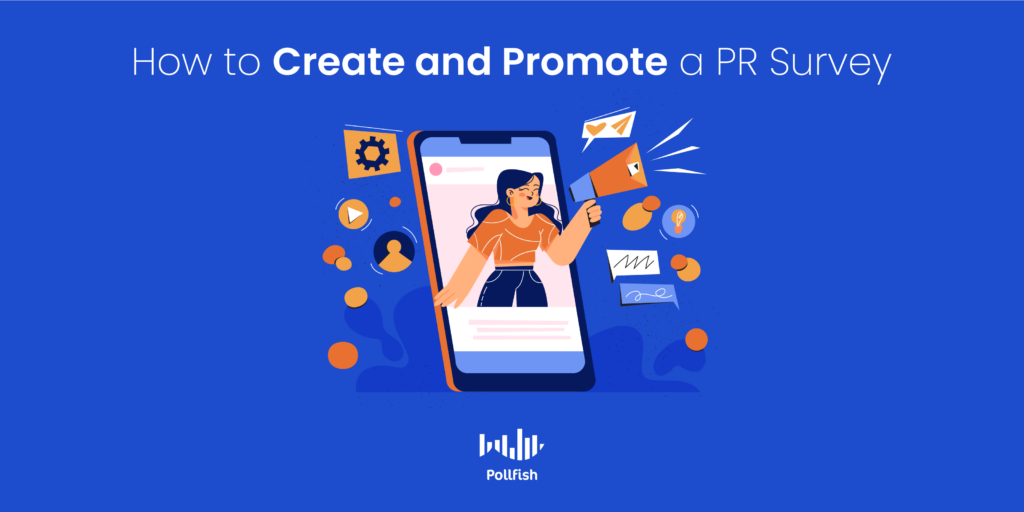
The following is an in-depth, step-by-step explanation on how to effectively create and promote PR surveys:
- Find a topic or issue that lacks information and would be interesting to provide insights on.
- This study can be centered on any of the 6 main types of research.
- Use topics that are timely and relevant to the public or to an industry to attract widespread media coverage.
- Avoid subjects already covered by other survey studies.
- Media outlets will ignore survey data that repeats what has already been made known in past campaigns.
- Journalists and other media workers seek out research that uncovers contrarian answers or something people don’t already know.
- Ask the right questions; when it comes to PR, ask questions that have a chance of extracting shocking answers, or those that are shocking in nature themselves. This is because controversial survey results often garner even greater media coverage.
- Avoid being overly self-promotion in your survey, especially if your survey studies past PR campaigns.
- Surveys that heavily rely on self-promotion perform poorly.
- Avoid being overly self-promotion in your survey, especially if your survey studies past PR campaigns.
- Check for statistical significance and consider the presence of possible survey bias.
- Make sure your study uses the proper survey sampling size before you conduct the survey. This will ensure your study carries statistical significance.
- Consider that biases are likely to occur in your survey. That’s why you’ll need to use a platform that can keep them at a minimum.
- Choose a potent online survey platform.
- Choose wisely, as the capabilities of the platform will dictate the scope and results of your survey study.
- Some platforms offer limiting features, those that won’t allow you to explore your subject as well as more well-equipped platforms can.
- Your survey platform of choice should also allow you to make your own survey in only a few steps to save you the time and hassle often associated with market research projects.
- Promote your survey.
- Since this is a PR survey, you can maximize your PR efforts on the study at large by advertising it via PR methods, such as press releases or media placements.
- Additionally, you can promote it via social media, direct mail or online ads. This should boost the online responses you’ll receive from the surveys being deployed across publisher networks.
- Consider using survey incentives.
- These will drive interest to your survey, allowing it to be completed sooner.
- You can also use incentives as a marketing tool, framing your brand in a positive light if you mention it in the survey.
- Incentives generally provide positive experiences and will allow your company to stand out from others.
Making Headway in PR and Beyond
The results from PR surveys can be powerful, convincing, and influential enough to go beyond securing media placements, but to live in the minds of your target market for a considerable subsequent period.
In order to execute useful PR surveys, you need to opt for a well-equipped online survey platform to carry out the campaign to its full potential.
This kind of online survey platform should field surveys locally or globally, use random device engagement (RDE) sampling to reach respondents in their natural digital environments, deploy surveys to a wide network of highly-trafficked websites and apps, offer artificial intelligence and machine learning to spot survey biases and disqualify poor-quality data, provide a mobile-first approach and much more.
With such a survey platform in tow, you are in good hands for conducting PR surveys and raping all of their benefits.
How to Properly Kick Survey Lead Generation into Gear
How to Properly Kick Survey Lead Generation into Gear

Advancements in market research software have given rise to survey lead generation, boosting how companies gain new leads.
As such, the correct online survey platform grants businesses another avenue for gaining new leads, instead of solely relying on traditional methods.
Generating leads is a crucial part of the sales funnel, allowing brands to progress on kick off their customer buying journey. 53% of marketers spend at least half of their budget on lead generation, given the value of obtaining new leads. For example, leads are 9x more likely to convert when businesses follow up within a few minutes.
Despite the value that generating leads brings, along with the hefty spending that goes into it, 61% of marketers say generating leads and traffic is their top challenge.
This article explores how to establish survey lead generation with the correct online survey provider.
Understanding Survey Lead Generation
This concept is borne out of the marketing practice of lead generation, which involves initiating consumer interest and/ or inquiry into a business and its offerings.
The lead in this concept is a consumer of business who is a good fit for your product or service. Also called a prospect, this business entity can be a prospective customer or a consumer who your business has interacted with, either via sales, digitally, etc.
Although casting a wide net across your target market seems intuitive, companies shouldn’t pursue all of their leads, as they are not all marketing qualified.
Your business ought to focus on nurturing marketing qualified leads, or MQLs only, as they are the leads who have indicated interest in your brand’s offerings, based on your marketing efforts. They are also the leads that are most likely to become customers.
Lead generation involves using traditional methods, such as via cold emailing and calling, list building, e-newsletter list acquisition, events or any other sales efforts. Survey lead generation is one of the latest forms of lead generation.
This practice depends solely on surveys to spawn interest and inquiry into a brand. While it may appear to be high-flown and impossible at worst, surveys are potent tools for forming leads — when used with a strong online survey platform.
That’s because surveys allow market researchers to get to the heart of any and all customer concerns, needs, desires and aversions. This allows businesses to better understand them and cater to them.
What’s best, however, is that there are other ways you can use surveys directly for lead generation.
Using the Correct Survey Questions for Survey Lead Generation
Surveys allow you to quickly gain access to questions bent on determining whether a lead is an MQL worth pursuing for your business. There are strategic ways to set up your survey questions to successfully forge survey lead generation.

These kinds of questions can specifically gauge how useful of a lead your respondents can and will be for your company.
Your business can form these questions to use them with your B2B surveys, along with your B2C consumer surveys, in order to examine your respondents’ stance on your company, their needs and readiness to either use your product or move further down the sales funnel.
Use the following questions in your survey lead generation campaign to better understand your leads and classify them as MQLs or non-MQLs:
B2B Lead Generation Surveys
- What are your prospects’ biggest pain points?
- Answer type: Multiple-selection, open-ended field option
- What kind of content do they prefer to consume?
- Answer type: Multiple-selection
- What kind of issues does your company experience in regards to [industry problem, lack, need, etc.]?
- Answer type: Multiple-selection, open-ended field option
- How do you typically work to resolve this problem?
- Answer type: Multiple-selection, open-ended field option
- Do you make buying decisions at your company?
- Answer type: Yes or no, scaled answers, ex: I make some decisions, I work with someone who does, I rarely make purchasing decisions, etc.
- Have you heard of [your brand] in regards to [the problem]?
- Answer type: Yes or no, use advanced skip logic to route them to the following question:
- Would you consider purchasing [brand] that solves your issues? Or try to use it first?
- Answer type: Yes or no, scaled answer
- Are you ready to make a purchase and when?
- Answer type: Multiple-choice such as this month, quarter or year
B2C Lead Generation Surveys
- What are your biggest pain points in [industry, niche, needs, etc]?
- Answer type: Multiple-selection, open-ended field option
- What kind of content do you prefer to see, read or consume?
- Answer type: Multiple-selection
- What kind of issues do you experience in regards to [industry problem, lack, need, etc.]?
- Answer type: Multiple-selection, open-ended field option
- How do you typically try to resolve this problem?
- Answer type: Multiple-selection, open-ended field option
- What kinds of products do you use for this problem?
- Answer type: Multiple-selection
- What brands do you typically use to solve this problem?
- Answer type: Multiple-selection
- Are you willing to try a new company for this problem/need?
- Answer type: Yes or no, scaled answers, ex: I might consider it, I might consider it only if the price is right, etc.
- Have you heard of [your brand] in regards to [the need/ problem]?
- Answer type: Yes or no, use advanced skip logic to route them to the following question:
- Would you consider purchasing [brand] that solves your issues? Or try to use it first?
- Answer type: Yes or no, scaled answer
- How important is the price in your purchasing decision?
- Answer type: Scaled answer with the range of not important at all to extremely important
How to Leverage Surveys for Survey Lead Generation
Aside from using the above questions to gauge whether your respondents would make qualified leads for your business, there are other techniques you should consider to establish survey lead generation.

You can hammer out your surveys in a way that makes your business appear more attractive to your target market, thereby allowing you to obtain more leads. There are several approaches to achieve this end. They include the following:
- Fully understanding customer pain points.
- Understanding customer pain points is crucial before customers begin their customer buying journey. If you don’t understand their basic needs and issues, you won’t be able to cater to them, whether it is in your messaging, product or experiences.
- You can push your prospects further down the funnel faster by refining your marketing collateral. To do this, you can survey your target market specifically on their pain points. This will give you insight into what keeps your consumers from buying and how your company can help them.
- If you mention your business explicitly in these surveys, you are positioning your brand in a good light, one that shows your customers that you care about rectifying their issues and fulfilling their needs.
- Increase satisfaction
- Surveys allow you to increase the satisfaction associated with your brand. To do so, you would need to directly mention your brand, including its logo, slogan, services offered, company news, etc.
- You can increase satisfaction via surveys by offering either monetary or non-monetary survey incentives. Everyone loves perks and when it comes to your business, it’s beneficial to let respondents know that their incentives come specifically from your business.
- You should also ask specific questions on what your respondents are specifically looking for from your company and what you can do to better serve them. This will show them that you care about them as individuals. This also allows you to use these insights to later take part in marketing personalization.
- Improve your content strategy and nurture programs
- Surveys allow you to refine your content marketing strategy by seeking out the following from your target market itself: how customers consume content, their content preferences and stage in their customer journey.
- Being able to understand what kind of content drives more customers’ time on site and what kind resonates with them will ensure you create high-performing content each time. Additionally, it will help you form better nurture programs, from drip campaigns, to social media content, webinars and more.
- By choosing the correct insights to inform your content strategy, such as the format, topics and more, you can establish smart lead nurture programs. You can do so by funneling your respondents into the appropriate content streams based on their responses, in turn sending them engaging, educational, and convincing content.
- Identify the Best MQLs
- You can conduct market segmentation with surveys to get more closely acquainted with the makeup of your target market. This allows you to identify and categorize your various groups of customers into customer segments.
- You can also identify customer personas as a means of further organizing your consumers into distinct individuals.
- When you segment your customers, you can also find the most ideal marketing-qualified leads. When analyzing your consumers, surveys allow you to find which customer segment and persona has the largest amount of MQLs.
- You can also route MQLs to pages that used lead generation, such as landing pages, contact forms and more, but you would need an online survey platform that offers advanced skip logic to route respondents to relevant follow-up questions and links.
- Create referrals and build customer advocacy.
- By using a survey type that asks respondents to rate their likelihood of referring your company to others, you can gauge whether your respondents are detractors or brand advocates.
- Use a scaled survey, such as an NPS survey to discover how customers rate your company in terms of their willingness to recommend it.
- You can create brand advocacy by having customers refer your company to others across media and outlets. Brand advocacy is an organic means of creating lead generation by having loyal customers refer your business.
Making the Most of Your Leads with the Right Market Research Platform
It’s more important to stand out among the crowd that is your niche in the present day of expanding ecommerce and phygital companies. Doing so will allow you to boost your lead generation and acquire loyal customers.
Lead generation is not without its challenges. In order to crack all these challenges, you ought to conduct market research on your consumer base to lure it to your brand. To conduct market research, you need to use robust market research software, the kind that provides high-quality data and speed to insights.
A good example of this is an online survey platform, the kind that offers a mobile-first approach for agile research, random device engagement (RDE) sampling to reach respondents in their natural digital environments, artificial intelligence and machine learning to disqualify poor-quality data and fraud and much more.
This kind of online survey platform will augment all of your lead generation efforts, as surveys get to the heart of customers, allowing you to identify MQLs, better serve all your consumers’ needs, convert them and even forge brand advocates.
Discovering the Correct Survey Sampling Size for Your Market Research Study
Discovering the Correct Survey Sampling Size for Your Market Research Study
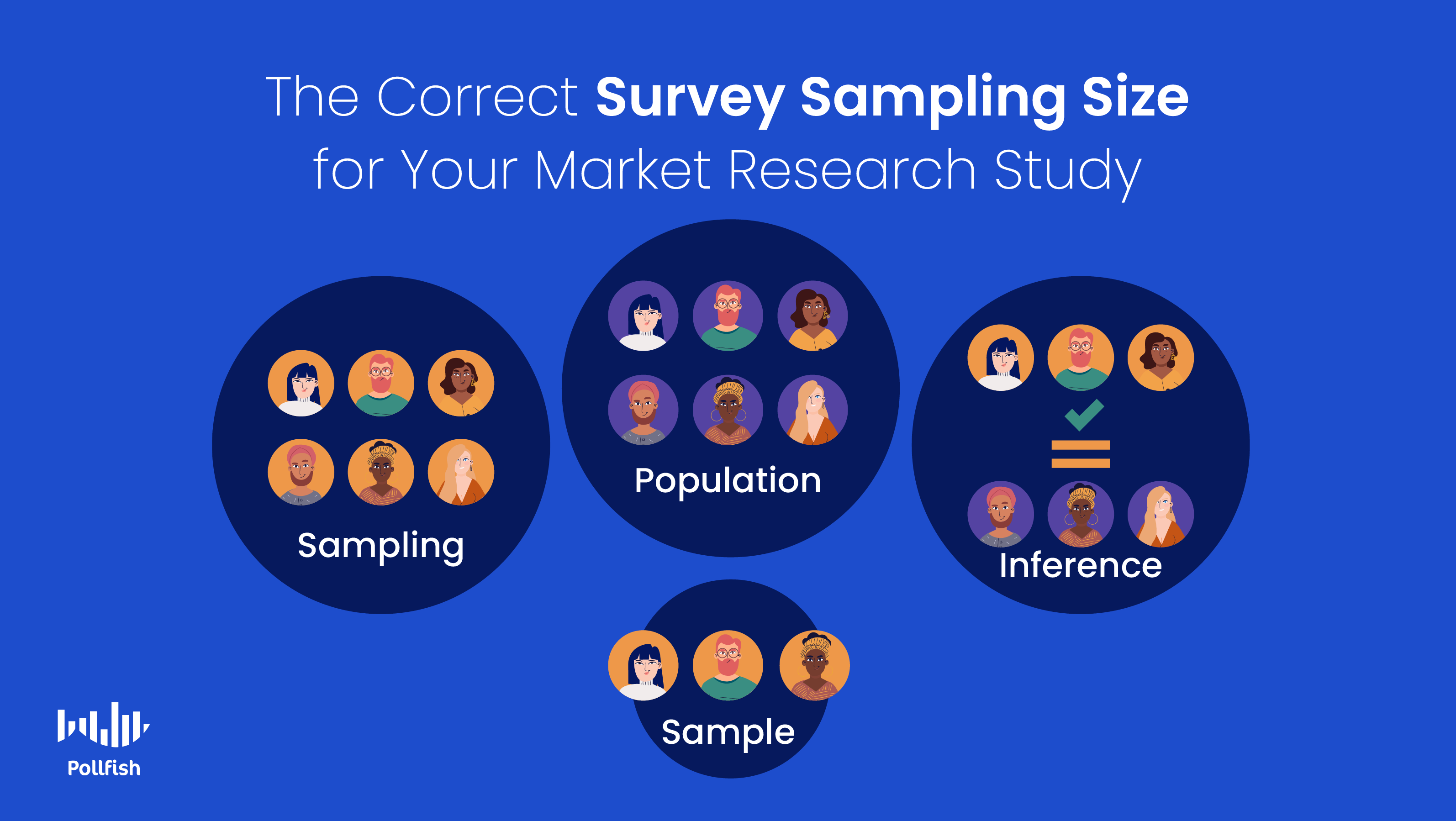
Determining the correct survey sampling size is necessary for establishing a statistically valid survey study. A well-founded survey study must be correctly designed and feature accurate conclusions, those that properly reflect the views of its target audience.
Although it is impossible to survey every member of a target population, your survey findings should be an accurate representation of the studied population. That’s where determining the correct survey sampling size comes into play.
However, even with the proper sampling size in tow, all surveys will undergo some degree of the sampling error. This is because surveys don’t extract the thoughts of every member of a population. Therefore, some findings will be inaccurate.
This article explains how to find the correct survey sampling size, its importance and the sampling size in relation to the margin of error.
Understanding the Survey Sampling Size
The survey sampling size refers to the number of respondents that take part in a survey study, which is also called the sampling pool. Used in market research and statistics, this size is usually determined with regards to the estimated size of the entire population under study.
This sampling pool is composed of a random sample of respondents who represent the studied population at large, as opposed to making up the entire population being studied, as it is impossible to survey every single member in a targeted population.
Market researchers need to determine the proper sampling size for all kinds of survey sampling methods, including probability or random sampling and non-probability or non-random sampling.
Aside from being calculated to find the size most appropriate for representing a large population, the survey sampling size is also useful for reducing the four types of sampling errors.
To determine the correct sampling size for your study, you’ll need to calculate it using several variables. (More on this in a later section).
The Importance of the Survey Sampling Size
The size of your sampling pool should never be random or made at a whim. Otherwise, you’re risking the quality and accuracy of your survey study. The survey sampling size is crucial on a number of fronts.
It is critical to market research campaigns, in that the sample size influences two statistical properties: the precision of our estimates and the power of the study to draw conclusions.
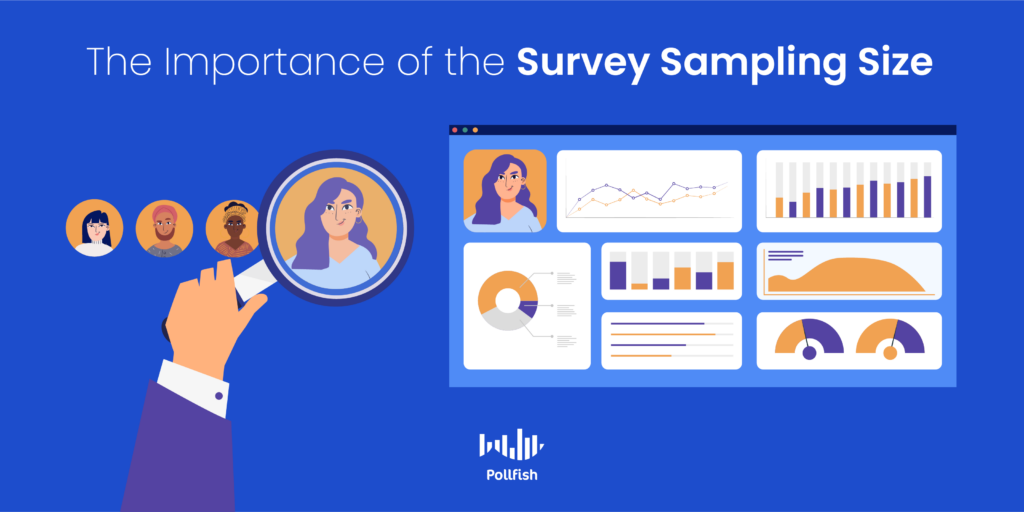
The survey study you run will always have some margin of error in the study results. This influences the precision of the survey results and their use to make predictions. Although this error is inevitable, it can be reduced with the correct sample size.
Larger samples are usually associated with a smaller margin of error. This makes sense when you consider the thousands and even millions of consumers that can fit under one segment of a target market, which can be the target audience of a survey campaign. As such, the larger your sample size, the more insights you gain that represent this audience.
However, there is a point when increasing the survey sample size has no impact on the sampling error. There are also plenty of instances when failing to use an appropriate sampling size undermines the entire study.
You should therefore be careful when calculating your survey sampling error, as both a sample size that is too large and too small will have substandard results.
What Happens When a Sample Size is Too Small
When a sample size is too small, its results will be inconclusive and, in many cases, such as in experimental research, unethical. Thus, in these cases, you won’t be able to make accurate predictions or take actions that require testing, as they may be dangerous. For example, you can’t expose humans or lab animals to possible risks associated with research.
Additionally, the data from this kind of sampling size will yield a disproportionate number of respondents with anomalous answers. These will skew the results, so you won’t retrieve an accurate understanding of the entire targeted population.
What Happens When a Sample Size is Too Large
Using a sample size that is too large is wasteful on both time and resources. It relies on more respondents than is necessary to carry out the survey campaign for accurate findings. With surplus data, the study is not representative of its target population.
This kind of sampling size will also incur more expenses to run the study, which could and should have been avoided.
All in all, an appropriate determination of the survey sampling size for a survey study is an essential aspect of the design of this kind of study.
How to Find the Correct Survey Sampling Size
As aforementioned, determining the correct survey sampling size involves using four variables. These are the population size, margin of error or confidence interval and sampling confidence level.
Once you’ve gathered the information you’ll need to determine the value of each, you can then proceed to the survey sampling size formula and simply plug them in.
Population Size
This variable refers to the total number of people in the population that you seek to survey. When dealing with broad populations, this size will likely be an estimate. For example, the population size of New York City is about 8.419 million people. A much smaller population, such as that of employees, is going to be definite.
Margin of Error
Also called the confidence interval, this is a percentage that relays how much you can expect your survey results to reflect the views of the overall population you’re surveying. Market researchers ought to aim for a smaller margin of error, as the smaller it is, the closer you’ll be to the exact answer at a given confidence level.
Essentially, it answers how much error you’ll have, which dictates how far a percentage will stray. For example, if 70% of respondents said yes to a particular question, with a margin of error of +/- 5%, then the correct percentage is straying by 5% points in either direction. As such, the true percentage is between 65 and 75%.
If you need to determine your margin of error, use the Pollfish Margin of Error Calculator.
Sampling Confidence Level
Although it has a similar name to the previous variable, this is a separate input, dealing with how confident you can be that the population would select an answer within a certain range. For example, a 95% confidence level means that you can be 95% sure the results lie between two certain numbers. The three most common confidence intervals are 90% confident, 95% confident, and 99% confident.
Standard Deviation
This variable Is an estimate of how much your responses will vary from each other and from the mean number. It studies how much individual sample data points deviate from the average population.
A low standard deviation shows that all the values will be situated around the mean number. A high standard deviation means the values are spread out on a much wider range and have very small and very large outlying figures.
Use the standard deviation of 0.5 to make sure that your sampling pool is large enough.
The Next Steps
When you have determined the value of each variable, fill them into the calculation in the section below. The following is a breakdown of the variables:
N = population size
E = Margin of error (percentage in decimal form)
Z = z-score
P = standard deviation
The z-score is the number of standard deviations that a given proportion is away from the mean. To find your proper z-score, use the table below as a reference:
| Desired confidence level | Z-score |
| 80% | 1.28 |
| 85% | 1.44 |
| 90% | 1.65 |
| 95% | 1.96 |
| 99% | 2.58 |
How to Calculate the Survey Sampling Size
Now that you understand each variable used to determine your ideal sampling size, use the following formula to calculate the correct survey sampling size for your particular survey study.
The formula is:
Sample Size = (Z² x P (1 - P) / E²) ÷ 1 + ( (Z² x P (1 - P)) / E² N))
Please refer to the following image for a more visual representation:
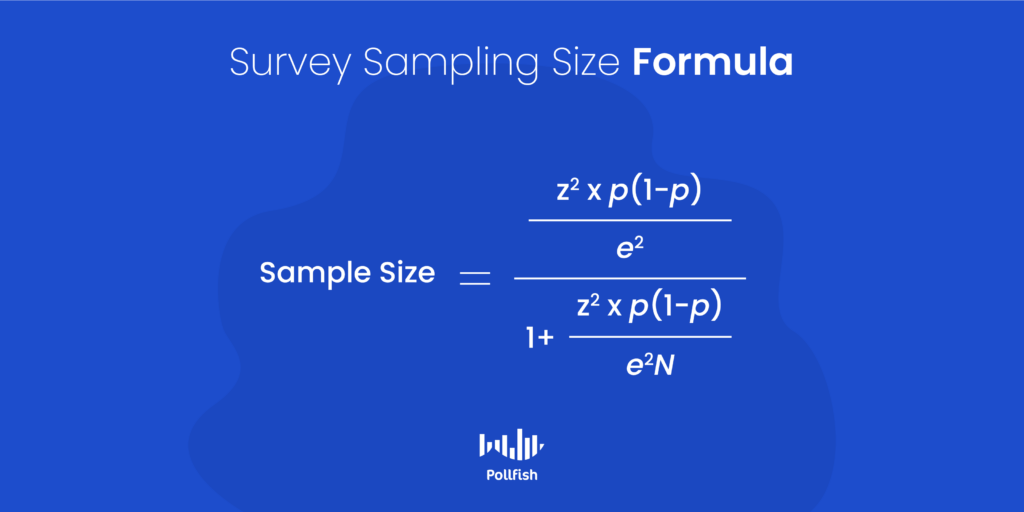
If you prefer a more efficient way to determine your sampling size, refer to the Pollfish sample size calculator.
Survey Sampling Size Tips
Calculating your sample size can be a complex process for those not familiar with statistical calculations or who don’t perform mathematics in their daily lives. There are a few key considerations that will help you make sense of the confusion.
Firstly, if you want a smaller margin of error, you will need to have a larger sample size given the same population. Next, if you seek a high sampling confidence level, you’ll need a larger sample size.
If your survey sample size becomes too big to handle, you can adjust the results by doing the following:
- decreasing your confidence level
- increasing your margin of error
Doing so will increase the chance for error in your sampling pool. However, it can also significantly decrease the number of responses you’ll need.
Optimizing Your Market Research with the Right Sampling Size
To optimize the findings of your survey study, you’ll need to use the correct survey sampling size. The correct sampling size will solidify the accuracy of your data and posit you as more of an authority figure in any of the six main types of research.
Additionally, it will give you peace of mind that the results you’ve extracted are accurate and can be used to take action, whether it is for a business or a research study in other fields.
In addition to an accurate sampling size, you’ll need a strong online survey platform to carry out all your survey campaigns.
We suggest using a strong online survey platform, one that offers agile market research and engages respondents in their natural digital environments via random device engagement (RDE) sampling. It should also be designed via a mobile-first platform, as mobile devices dominate the digital space.
When market researchers use an online survey platform with these capabilities, they are setting themselves up for success in all their survey campaign needs.
Driving Demand with Market Research Software
Driving Demand with Market Research Software

Driving demand is a constant need for all businesses, whether you operate a fledgling startup, or a long-established company. As one of the central goals that ensure business success, driving demand through lead generation is a top priority for marketers.
That’s why you need to focus your marketing efforts on an agile research strategy, the kind that doesn’t merely provide consumer research, but enables you to take meaningful action. Ideally, the actions you take should be effective in heightening the demand of your business's offerings.
In fact, 44% of marketers say that measuring the ROI of their demand generation initiatives is their top priority for 2021. While it is important, driving demand has its fair share of challenges.
This article explains how the correct market research software can be used for driving demand, whether it is for a product, a subscription, a service, or an experience.
The Importance of Driving Demand
Driving demand goes far beyond merely mustering desire, as it involves all feelings of interest and attraction from the customers towards a company. When businesses drive demand, they are improving across other key marketing functions and strategies.
A business with high demand requires funneling less attention and resources to brand awareness, as a significant portion of its target market doesn’t just already know about the business, but desires it in some way.
Additionally, businesses that excel in driving demand have larger levels of brand equity, the idea referring to the value that a brand derives from the state of having a recognizable name. When brands have high brand equity, they are well-known and achieve success. Businesses with high levels of demand thus produce equity, since, the more consumers seek it and its offerings, the more prominent it becomes in its market.
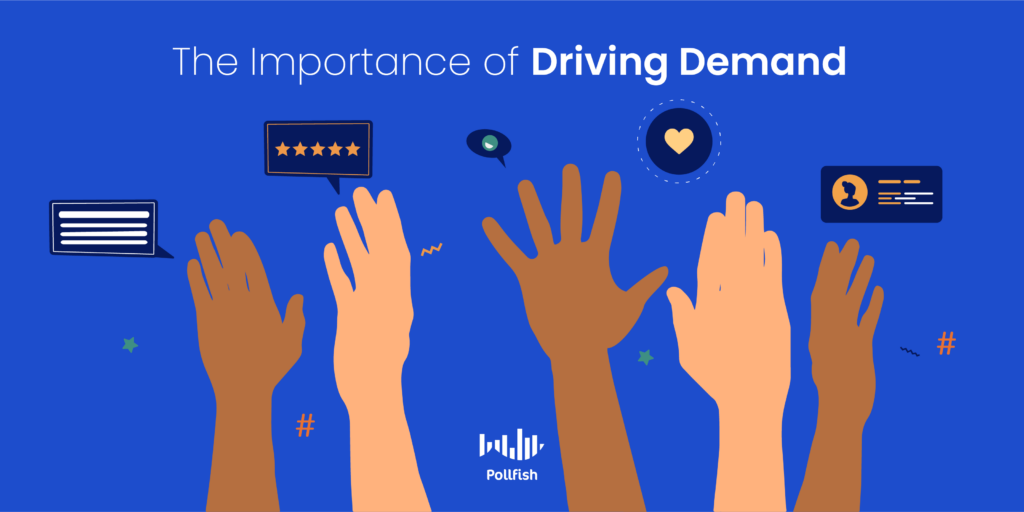
Brands with high demand also have a symbiotic relationship with cultural trends, in that these brands are responsible for forming new trends, as well as supporting existing ones. This too, raises a business’s popularity and equity.
What’s more, is that when a business becomes culturally relevant, it becomes deeply ingrained in the minds of its target market, along with those who are outside of it, who may one day become customers. This is to say that this kind of brand becomes harder to forget, thereby springing to mind when a customer thinks of their needs or a cultural trend.
Finally, when a brand exceeds in driving demand, it is building a relationship with its customers, paving the way for consumer loyalty, in which a target market chooses one brand over others in the same niche. This is especially important when it comes to establishing customer retention, which is more profitable and less expensive than customer acquisition.
When a business secures its customer retention within its customer base, it is able to increase the customer lifetime value (CLV) of many of its customers. This value expresses the profitability a customer will provide for a brand within their entire relationship with a business. As such, brands must first retain their customers, so that they build their CLV.
Driving Demand Across Various Functions
Driving demand is not merely a product-centric concept. On the contrary, it deals with generating conversion-bent desires and interests within many company aspects across your target market.
For example, some sources of demand include those found in your digital experience, such as a webinar you host, your social media content or your general site content. Additionally, demand can spring from other aspects of the customer experience, such as an enjoyable on-site shopping experience or interactions with your sales representatives.
The more functions and aspects for which you summon demand in your business, the stronger the demand for your company will be.
Fortunately, the proper market research software will allow you to garner customer and general market intelligence that focuses on driving demand. Given that consumer surveys provide a wealth of insights into customer buying behavior, desires and much more, the key is to use a strong online survey platform that can easily draw out granular customer intelligence on demand in relation to your company.
Understanding the Conditions & Functions for Driving Demand
As the prior selection explained, businesses can drive demand across various business functions and conditions. Given that there are many options for driving demand, your business ought to take advantage of as many as possible.
This is not just for the sake of profitability, as one business function may not yield the intended results as might another. Since these are business functions and conditions, they also contribute to other areas of business, working hand-in-hand with driving demand, but this is not their sole function.
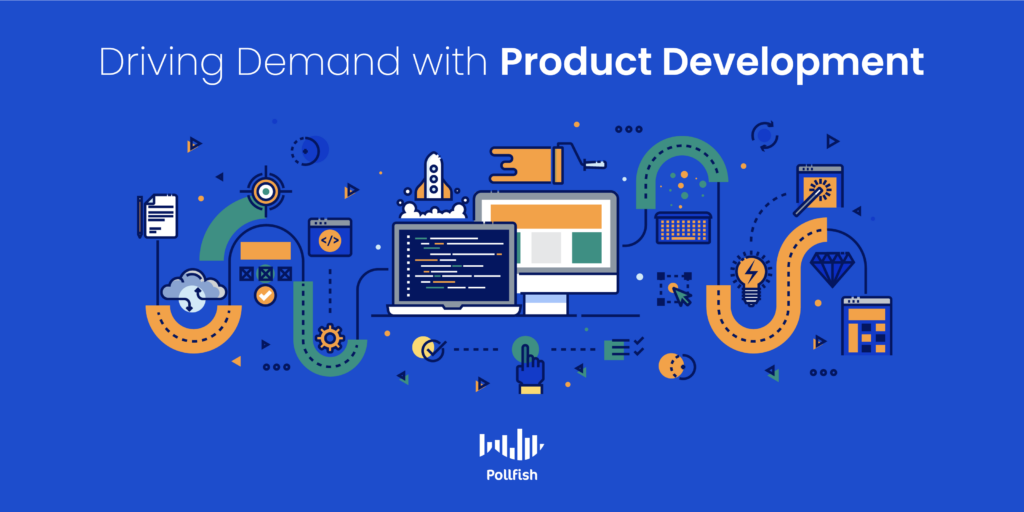
The following expresses all the different business functions and conditions that you can use to spike your demand. You can apply market research software to drive demand in all of these conditions:
- Product development
- Before launching a product, you need to assure that it satisfies current market demands for it to achieve any success.
- This involves taking part in the customer development process, a framework that dictates how businesses should bring a new product to market.
- You can also quiz customers on their needs by running a consumer survey that focuses on their needs and feelings about current market offerings.
- Product innovation and enhancements
- Brands must examine how their current products are perceived, where they are lacking and how they can be improved.
- You can test the efficacy and all opinions of your current products via the product satisfaction survey.
- Lead generation
- Generating leads is a must, as they are the key actors in the sales funnel, allowing brands to acquire more customers.
- You can use B2B surveys for generating business, vendor and partner leads.
- As for B2C leads, there are various marketing campaigns you can run, alongside market research campaigns to support them. This includes conducting market research for advertising.
- Customer experience (CX)
- This involves all the feelings that your customers develop surrounding their customer buying journey, including the pre-sales and post-sales stages.
- CX also involves individual interactions with a company, including individual experiences. For example, a grand opening in-store event, an interactive content asset, virtual tours, etc.
- You can apply the customer experience survey to learn what customers seek and desire from their experiences with your brand.
- Concept Testing
- A crucial aspect of establishing and marketing a new product, service or experience begins with concept testing, which allows you to gauge different concepts in relation to your target market.
- You can apply A/B testing to your surveys to directly test concepts, should the online survey platform you use offer this in-survey feature.
- Marketing Personalization
- Marketing personalization allows brands to connect with their target market, learn what best speaks to it and allows brands to cater to it more effectively, as opposed to taking the generic route.
- This drives demand, as 80% of customers are more likely to purchase when brands offer a personalized experience.
- You should rely on a market research survey to understand your target market on a deeper level, which will allow you to foster demand through personalization.
- Advertising and Messaging
- Advertisements and marketing collateral such as newsletters and website content propel consumers to make purchases.
- These messages, especially advertisements, use sponsored content and persuasion to move the needle in demand.
- Using market research software allows you to test ads before they launch, compare marketing messages and get a sense of what grabs your consumers’ interest.
Staying Ahead of Your Competition with the Proper Market Research Software
To secure your business’s success, you should never end your market research and marketing efforts with brand awareness and brand visibility efforts.
Instead, you must drive demand, as this concept doesn’t simply foster customer acquisition. Instead, demand powers your business by reinforcing the desires of your existing customers to continue patronizing your company and offerings.
Using market research techniques is an objectively potent approach to driving demand, as it allows you to study your target market and its various segments. Market research allows you to examine your customers’ needs and desires, so that you can effectively push demand in all areas of your business, from your CX, to content, to physical interactions to the products.
To conduct market research, you need to use robust market research software, the kind that provides high-quality data and speed to insights. A good example of this is an online survey platform, the kind that offers a mobile-first approach for agile research, random device engagement (RDE) sampling to reach respondents in their natural digital environments, artificial intelligence and machine learning to disqualify poor-quality data and fraud and much more.
When you’ve implemented a market research tool with these capabilities, you will be able to obtain insights into all the functions and conditions laid out in the prior section, along with other areas of business that drive demand.
How Surveys Help Make Critical Business Decisions
How Surveys Help Make Critical Business Decisions
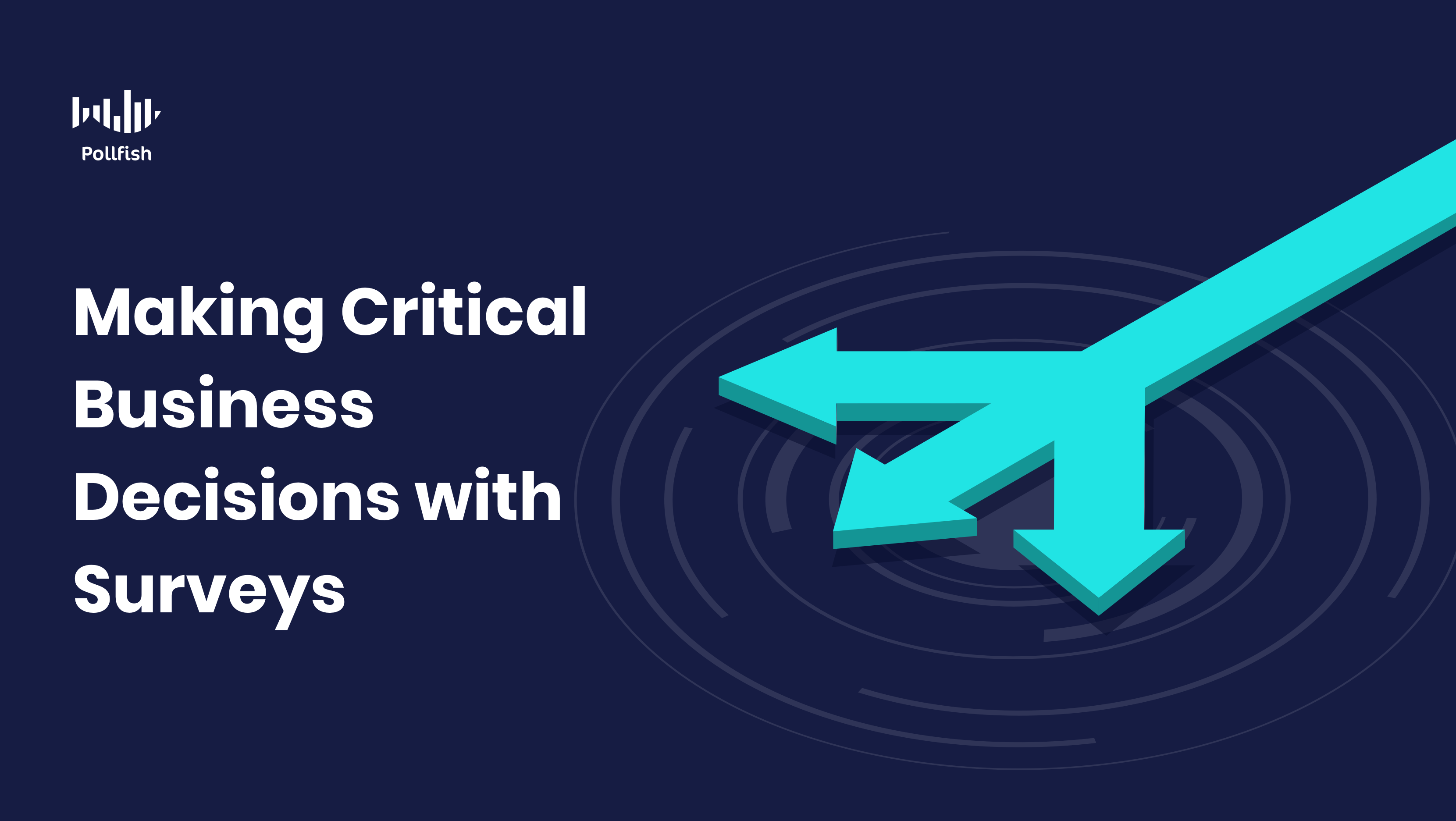
Making critical business decisions often require lengthy processes, which involve referring to your strategic planning process and business plan, along with proposals, meetings and lots of persuasion.
Rather than basing business decisions on inferences, which can originate from business documents and the advice of others, businesses ought to consider using data for decision-making. However, businesses need to take heed of context, as data that’s blindly applied is worse than useless — it’s misleading.
This is a problem virtually all businesses will come by, especially those investing in Big Data and AI. In fact, a large number of firms, specifically 64.8% of businesses invest in Big Data and AI. However, only 14.6% of firms have deployed AI capabilities into widespread production.
Businesses should therefore use data with a clear purpose, contextual insights, data filtering and neatly organized so that it is digestible and easy to understand.
This article discusses the weight of business decisions, the confusion and inaccurate conclusions springing from big data and the five key ways that surveys help businesses make crucial business decisions.
The Weight of Business Decisions & Avoiding Wrong Ones
There are plenty of decisions that executives need to make on a daily basis, from taking HR and other internal actions, to relationship-building with partners and clients, to setting goals and budgets.
It is critical for every business decision, regardless of its perceived importance, to be made with the best intentions and for the primary goal of benefiting the company in some way.
When executives and other higher-ups layout fine-tuned goals for employees, their workers will run into fewer issues and make fewer mistakes. Employees will therefore execute all that your business needs more efficiently.
It is key to note that changing business practices on a whim or when you are in a bad mood can have grave consequences. Every business decision should be carefully considered, and gain input from other employees.
Given that all business decisions carry some degree of importance, they cannot be made suddenly. Such decisions must be informed by data, particularly customer data if you’re seeking to form or test new marketing campaigns.
But as aforementioned, many businesses incorrectly use their data, as big data can be misleading, resulting in key stakeholders making the wrong decisions. This is especially true in large sets of data, as it is common to make causal links that appear to be legitimate, but represent fake statistical relationships.
Data needs to be contextual and allow researchers to make accurate decisions. As such, businesses need to conduct market research, specifically primary market research on their target market prior to making any changes or decisions.
In the mobile-first age, your business needs to make business decisions to not only suit your business needs, but to acclimate with the current mobile-first world. This involves your mobile properties, such as your mobile site and app(s), along with the way you conduct market research.
Survey research provides a strong means of gathering customer data, the kind that can help your business avoid the problems from big data.
How Surveys Help Avoid Issues and Make Business Decisions
Conducting survey research is a critical move to make when it comes to using the correct set of customer data and adapting to mobile-first. The proper platform facilitates ease of survey creation, deployment and organizes your data in an orderly fashion.
Given that surveys allow you to ask any question, set the theme of a survey campaign and form qualitative market research via open-ended questions, this kind of data provides all the contextual information your business needs to avoid the common pitfalls of big data.
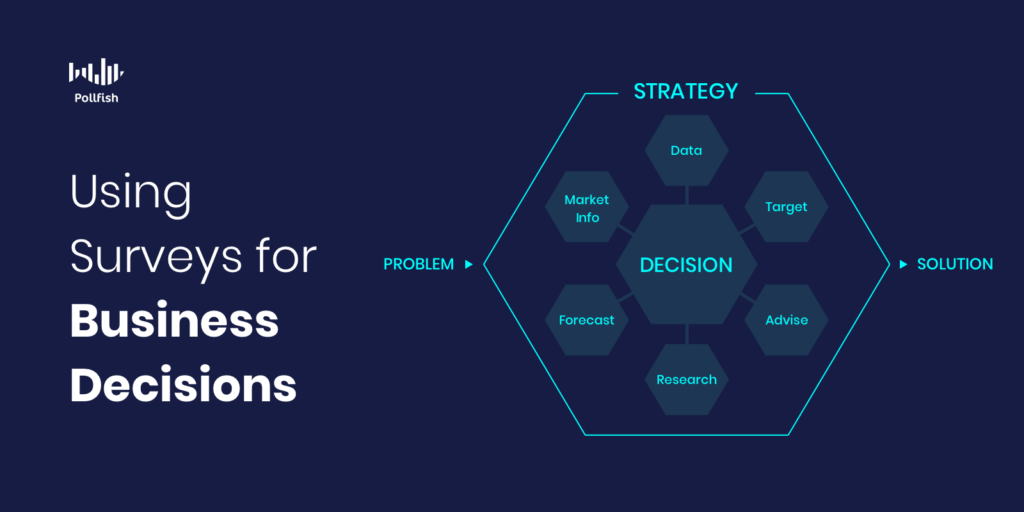
The following sections explain the five ways you can use surveys to make smart business decisions.
Testing creatives before launching a campaign
Marketing campaigns are often major undertakings that come with large price tags. To avoid any mistakes or issues, such campaigns need to first be tested before launching. Surveys steer all those on the creative side of a team in the right direction, as insights from these tools help creatives form and develop their concepts, making them crucial components of concept testing.
Surveys allow marketers and creatives to take more risks with content by first creating a survey to test different versions of a content idea. Then, they can understand the opinions and feelings of their respondents on a high level, along with examining their reactions more deeply, such as with open-ended questions, which are qualitative in nature.
Understanding different customer segments
Marketing endeavors — or any others — will never hit the mark when you don’t understand your target market, the broad group of customers that are most likely to buy from your business. In order to properly market to and serve your customers, you’ll need to understand them precisely, which includes understanding the segments that make up your target market.
Surveys make this possible, as they are a primary source of executing market segmentation, in which market researchers can divide and organize their target market into smaller groups based on their shared characteristics, such as demographics, location and behaviors. This makes it easier to form marketing campaigns, as you can design them specifically for each segment.
This technique is also ideal for market research, as it allows businesses to study their customers in a more organized and granular manner. If you don’t understand the nuances behind your customers, along with their preferences and aversions, you won’t be able to create messages or innovate on your offerings in a way that is relevant to them.
Understanding what consumers think of your competition
Surveys help you make critical business decisions by way of conducting competitor analysis. Although surveys are deployed to the masses, which includes your target market, you can use them to ask consumers for their thoughts on your direct and indirect competitors.
Whether it is about other businesses in a geographic area or other ecommerce businesses surveys allow you to understand the standing of other businesses in your market. Surveys unveil whether consumers are aware of your competitors, thus allowing you to gauge your competitors’ brand equity, along with what consumers like and dislike about those businesses and their offerings.
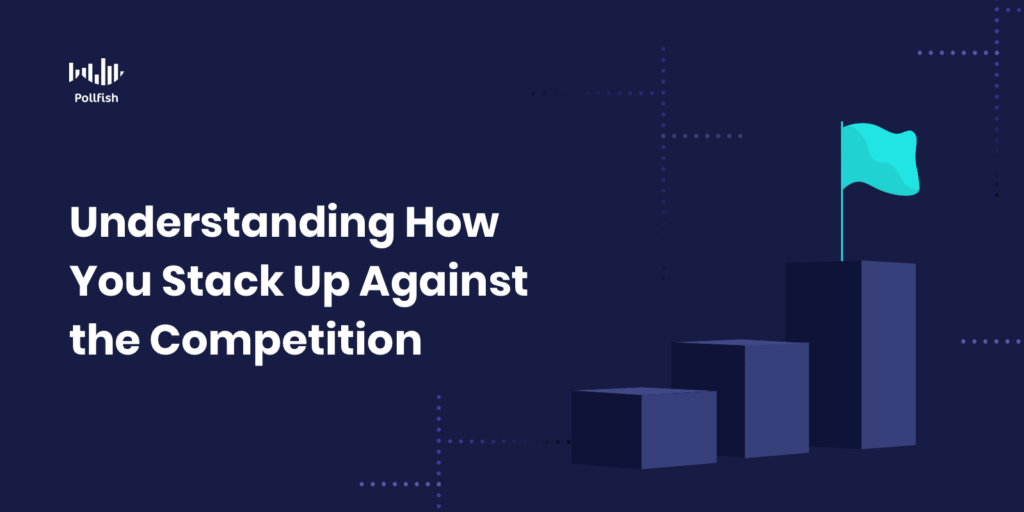
In this way, they can also educate you on your market at large, such as its key innovations, demands, movers and shakers, key events and more. As such, surveys are instruments for understanding both your competitors’ performance in the eyes of your consumers and their thoughts on your industry at large.
Spotting trends early
The latest trend may stay culturally relevant to your target market for a while, but it also may just be just a passing fad. Surveys help teams become attuned to cultural trends, current events and the general sentiment around them. With this tool in tow, your team can test their ideas in relation to trends and back them with data.
This includes data on where your industry and niche are heading. Surveys grant you these insights with the potential of spotting trends early on, so that your team stays ahead of the curve and can capitalize on them quickly. Surveys are the perfect tools for adapting to new trends and practices, as their results are available in nearly real-time. (This will depend on the online survey platform you use).
Get feedback on new product ideas
Innovating on products is often difficult; it would be especially unfavorable to launch a product without understanding how your target market feels about it. Perhaps the new product or feature will be useful to your consumers, but there is a chance of it disappointing them.
For example, you may think you’re adding a useful feature or removing an inconvenient feature, while your customers never needed you to take these actions, proving the adage of “if it ain't broke, don’t fix it.” After all, some features, like a USB outlet on a laptop are necessary, but brands may remove it, incorrect about their assumption that it is unneeded. In turn, customers have to hassle with finding the correct adaptor.
Thus, innovation is important, but it carries a lot of risks. As a business owner or market researcher, you need to be wary of these risks, how to minimize them and to innovate in ways that are truly beneficial to your target market. Surveys allow you to do all three, as you can assess product development by asking the right questions.
Surveys are key tools in customer development, a framework part of the lean startup concept, used to ascertain whether a product satisfies the needs of your target market. Surveys also complement an in-home use test, a market research technique that allows researchers to test a new product by way of sending it to a customer's home rather than sending the customer to a facility to try the product.
Making all the Correct Business Decisions
As a business owner or market researcher, you owe it to yourself and your team to make wise decisions to enable employees to trust you and to steer the company in the right direction. All business decisions are important, whether they involve customers, products, vendors or employees.
Surveys allow businesses to properly cater to all of these entities, whether it is marketing to a target market, innovating on products or serving your employees. This is because you can create campaigns centered on virtually any topic, allowing you to understand your target market’s opinions on anything you like.
However, not all online survey platforms are built with the same capabilities. Your business needs to find a strong survey tool that allows you to make your own survey in just three steps, uses artificial intelligence and machine learning to weed out poor-quality survey data and implements random device engagement (RDE) sampling to engage respondents in their natural digital environments, as opposed to using pre-recruited participants.
When your business leverages survey software that offers these functionalities, you’re set to make critical business decisions without hesitation.











